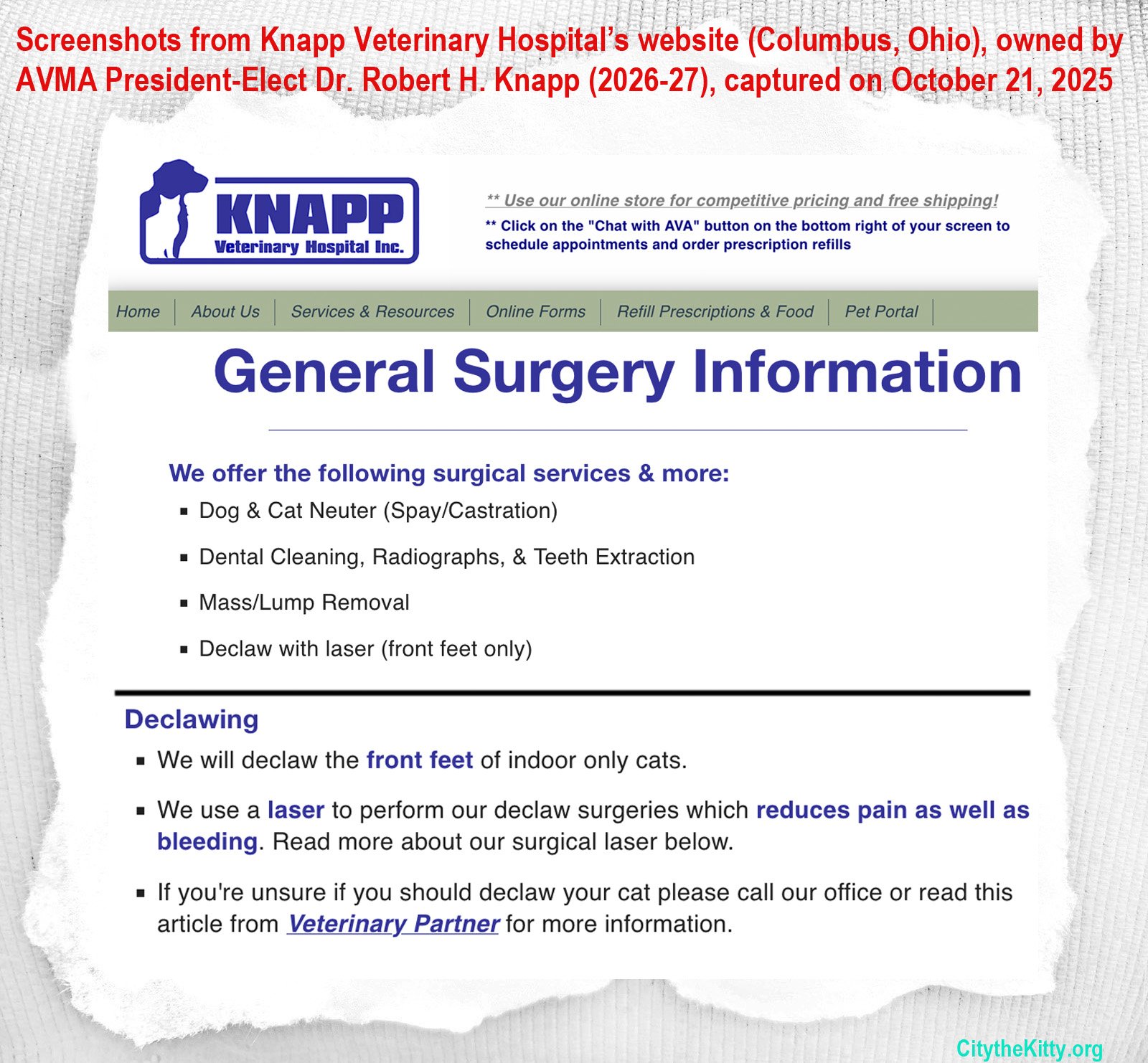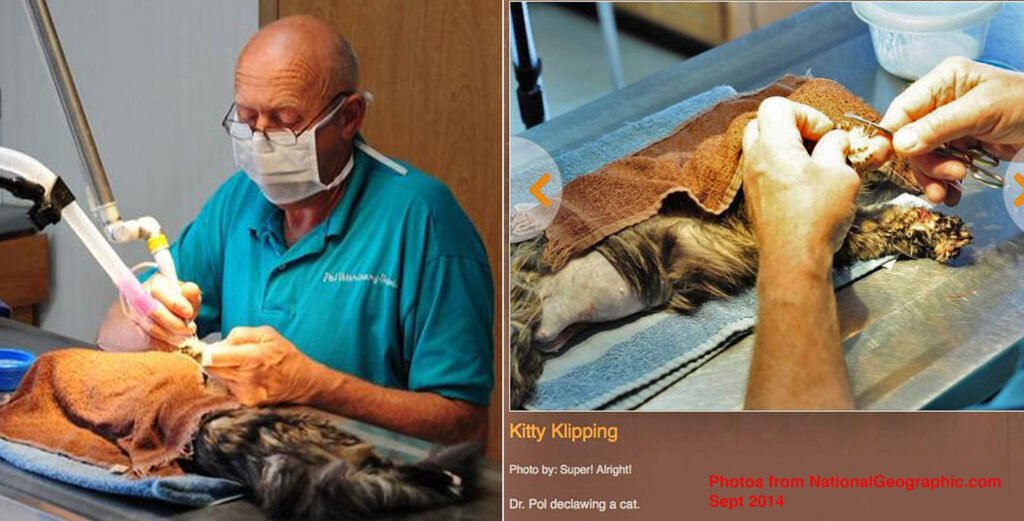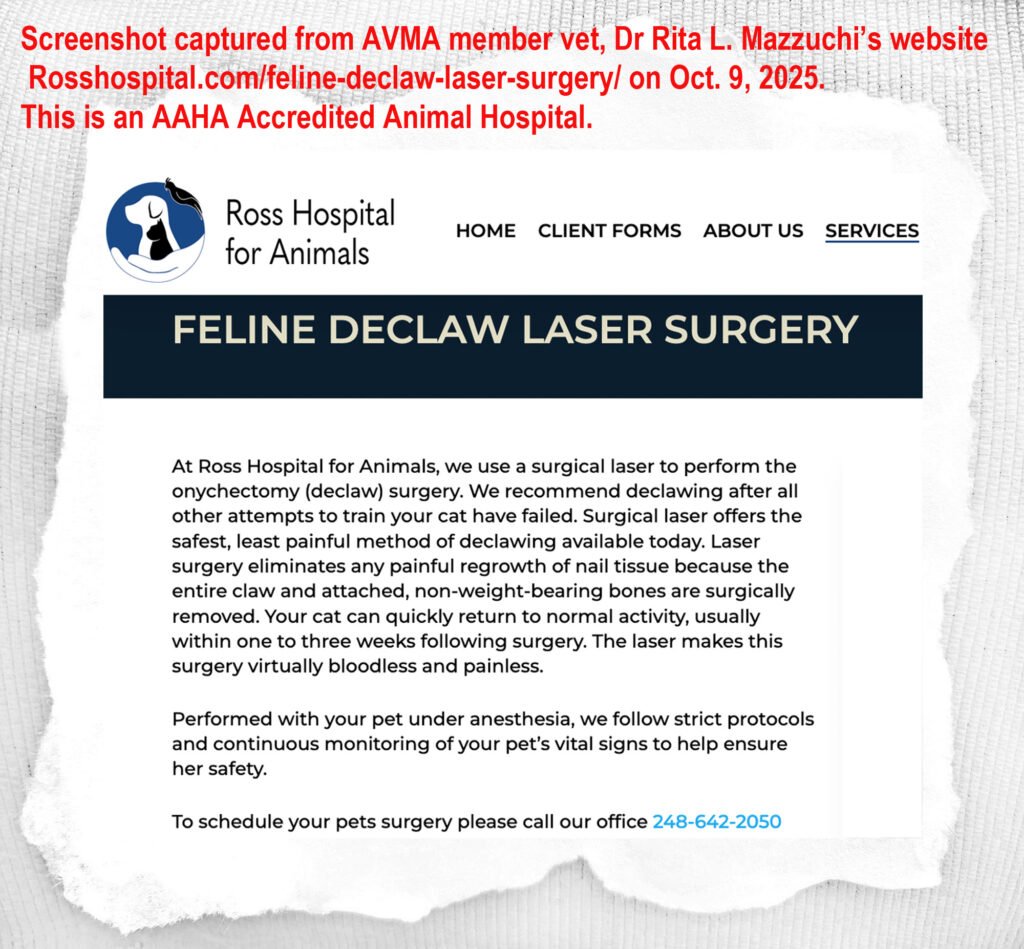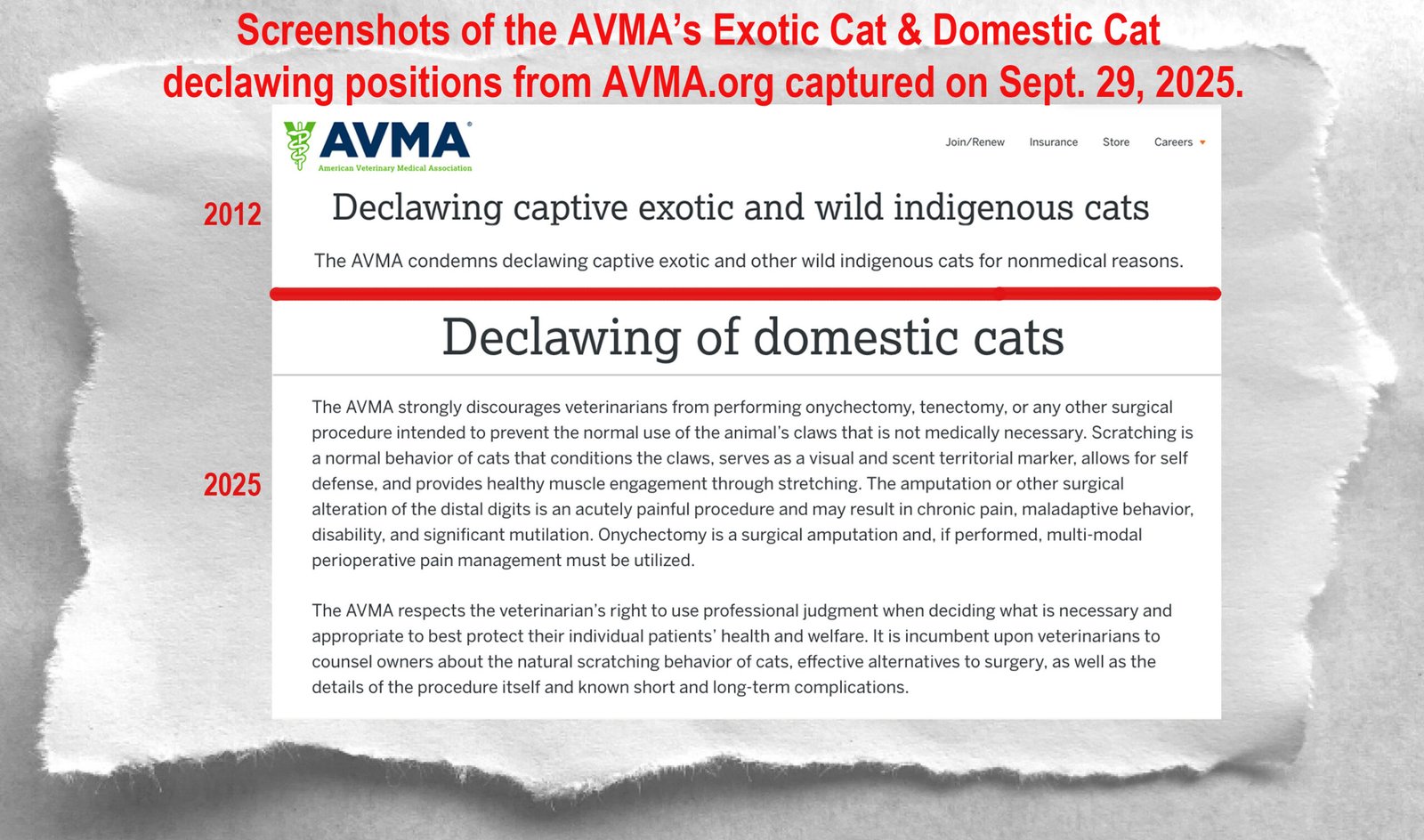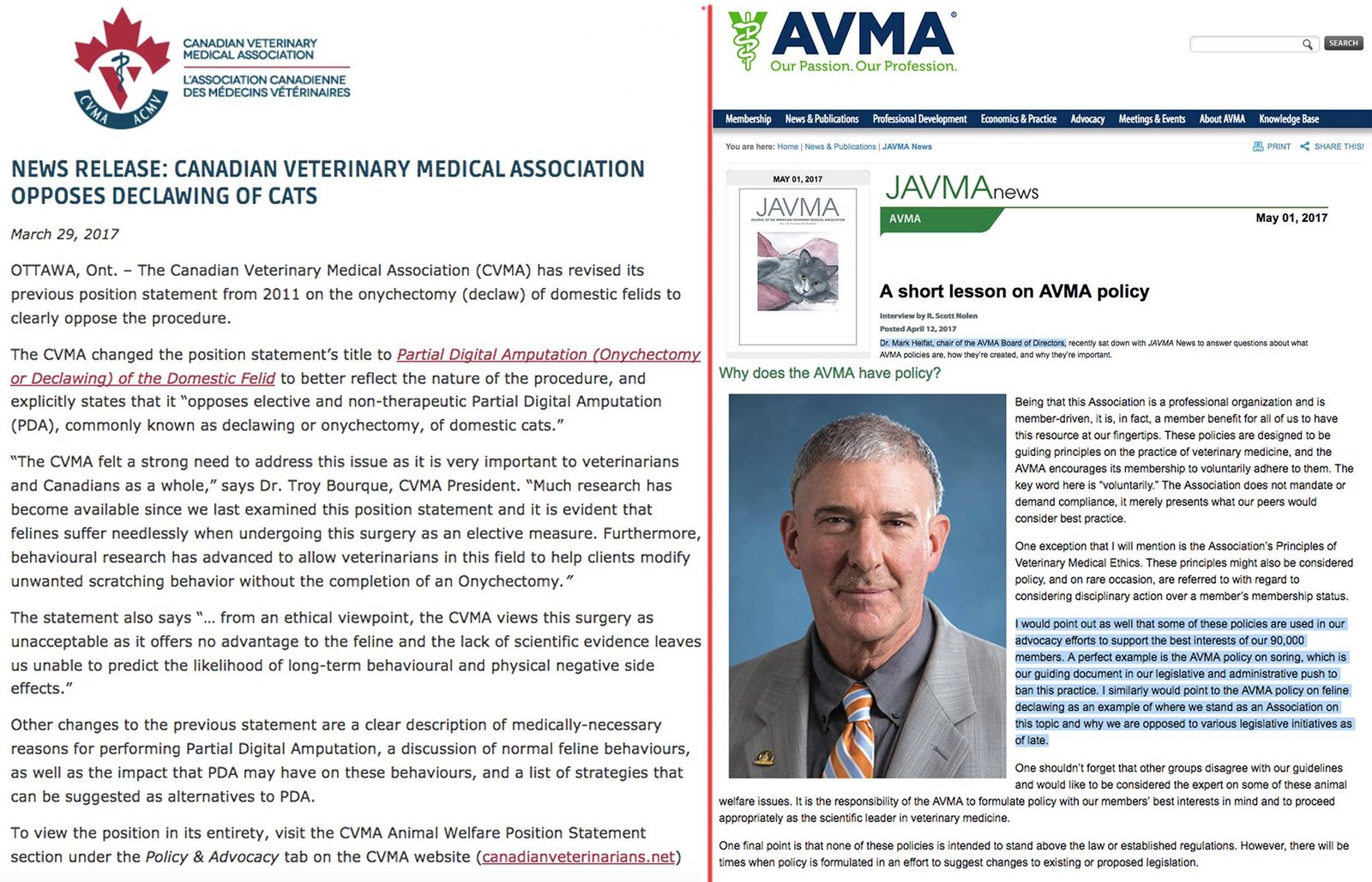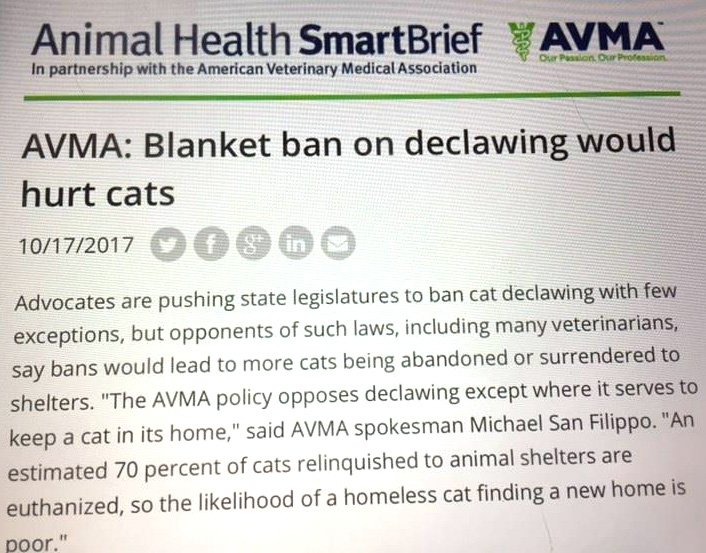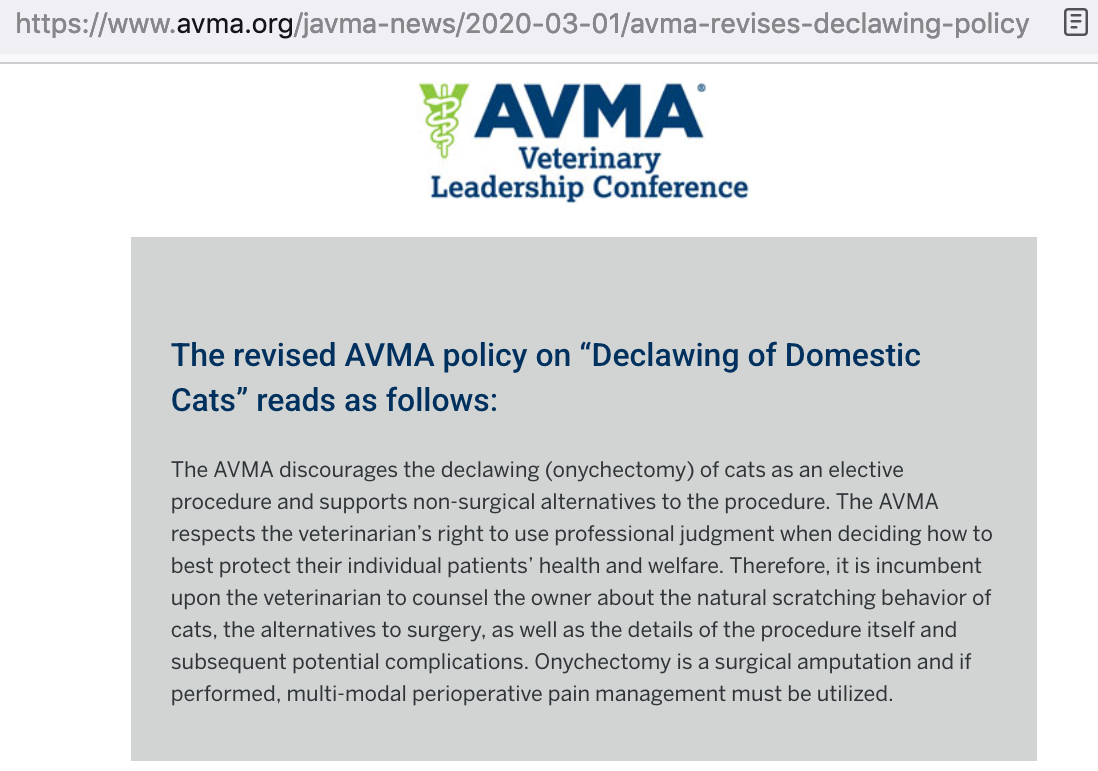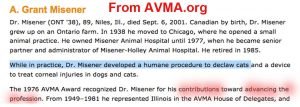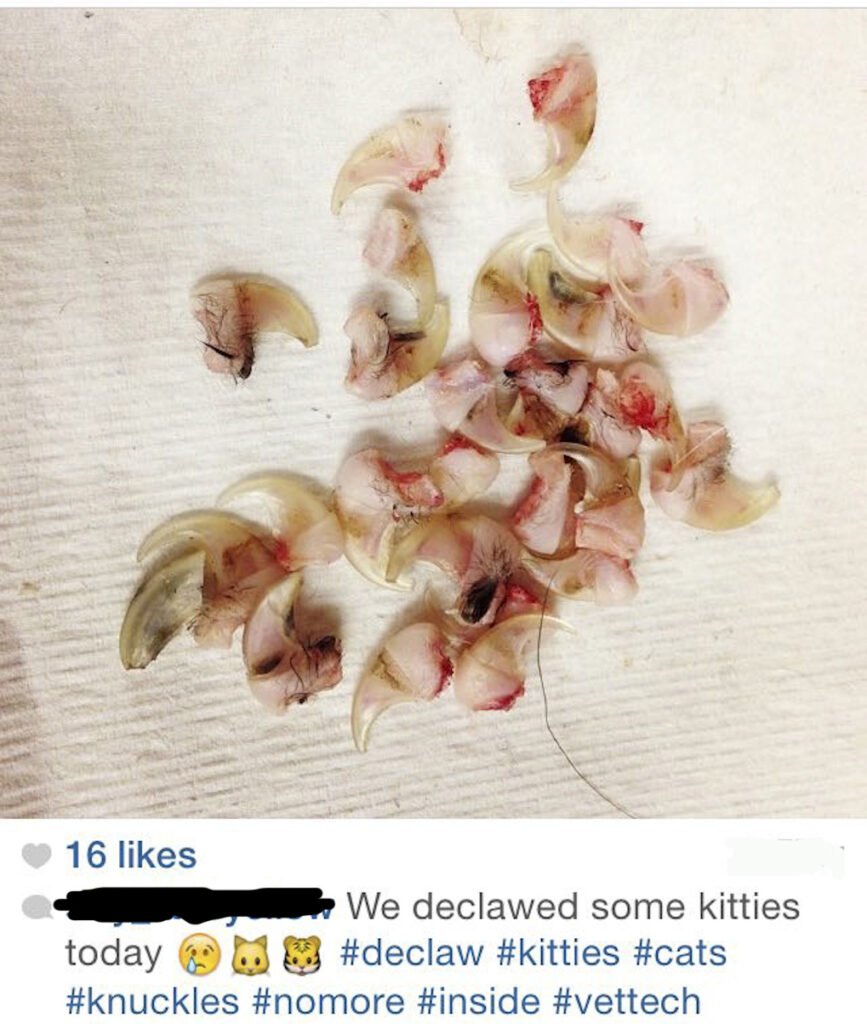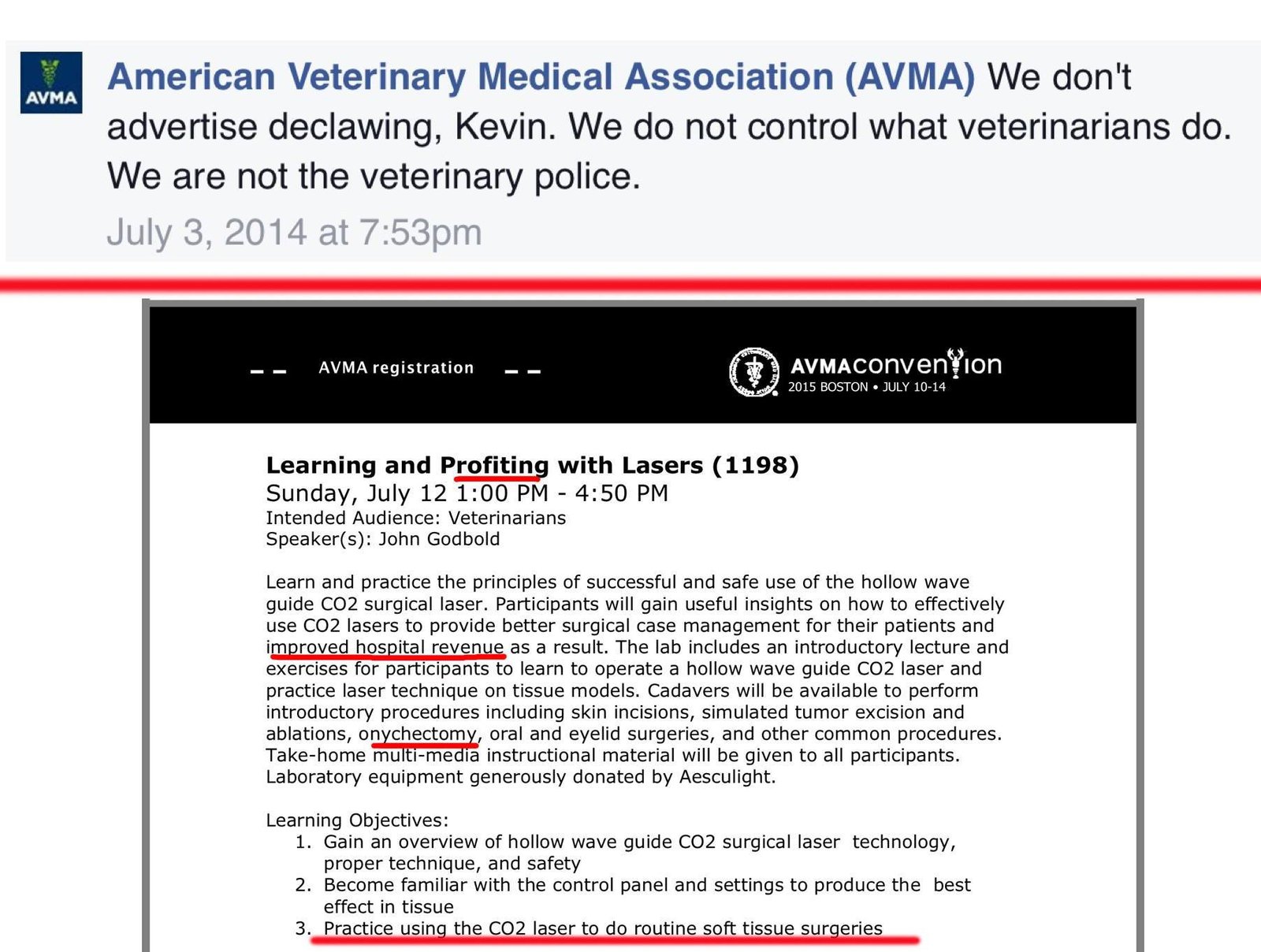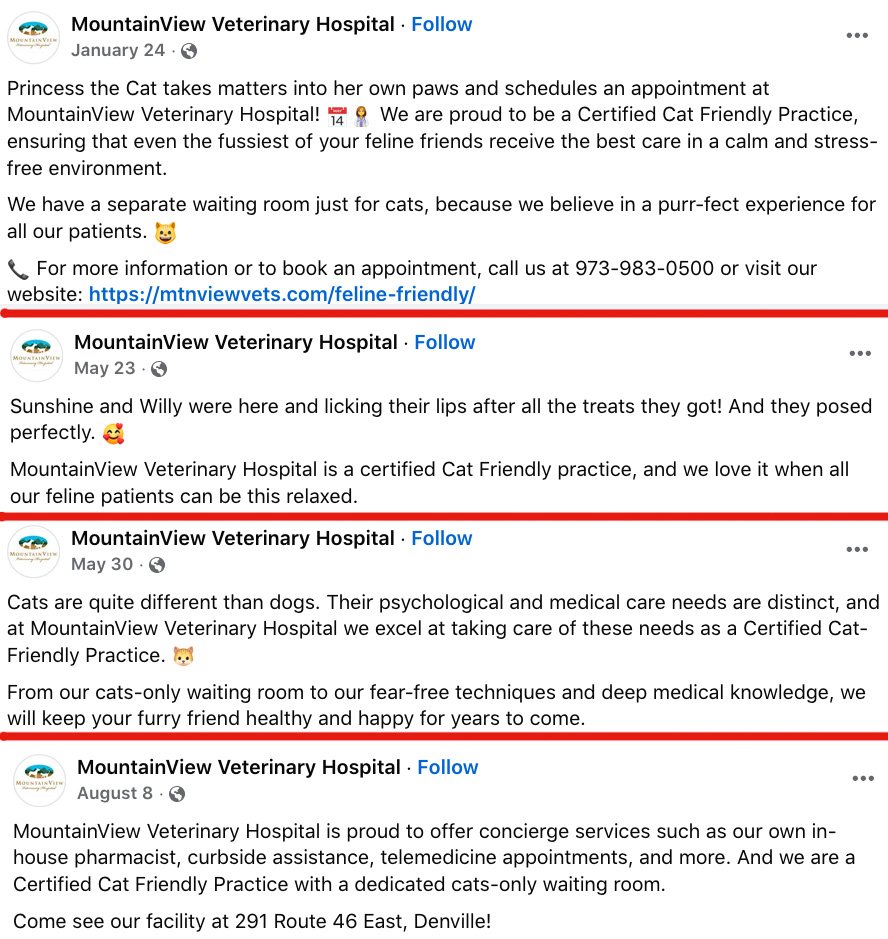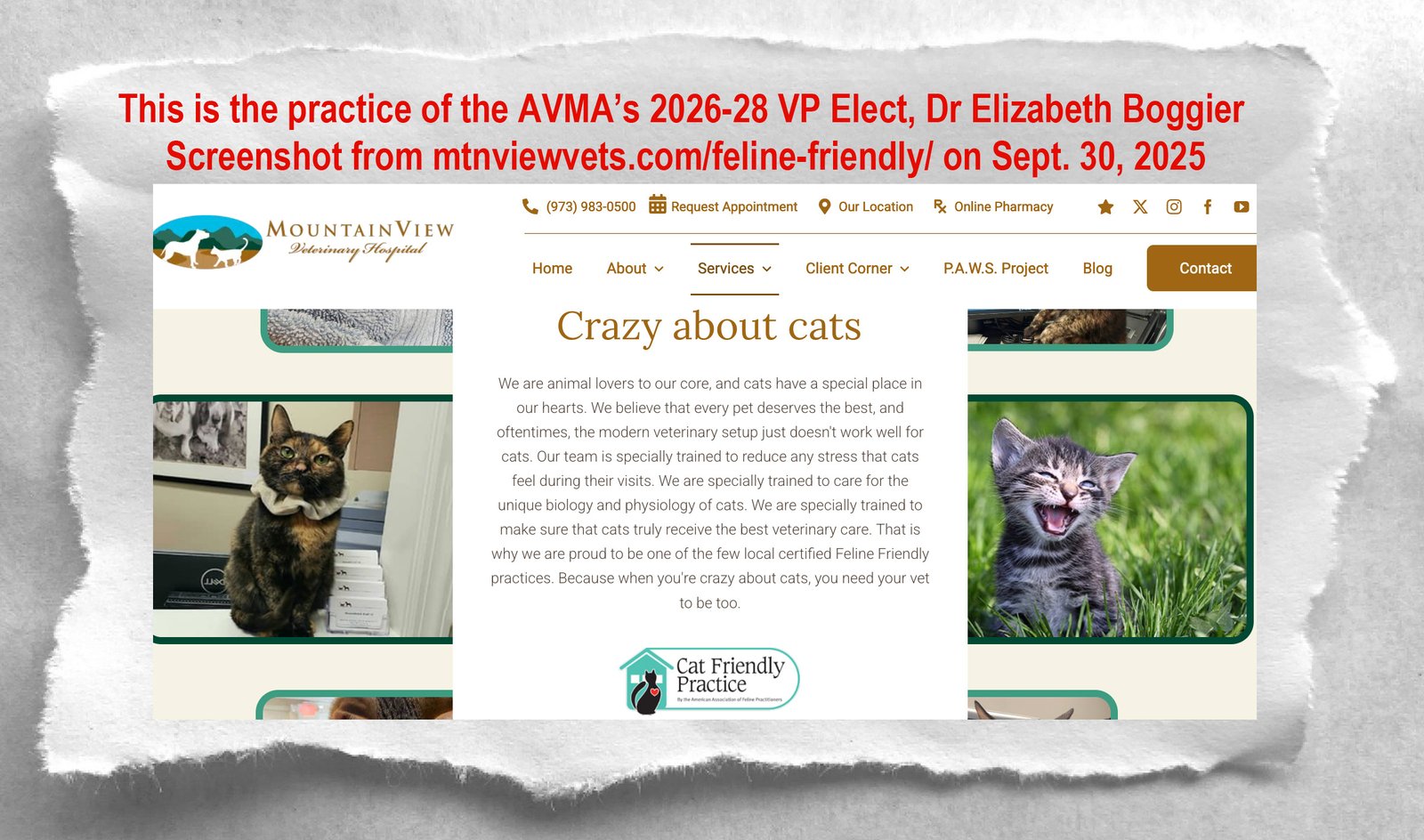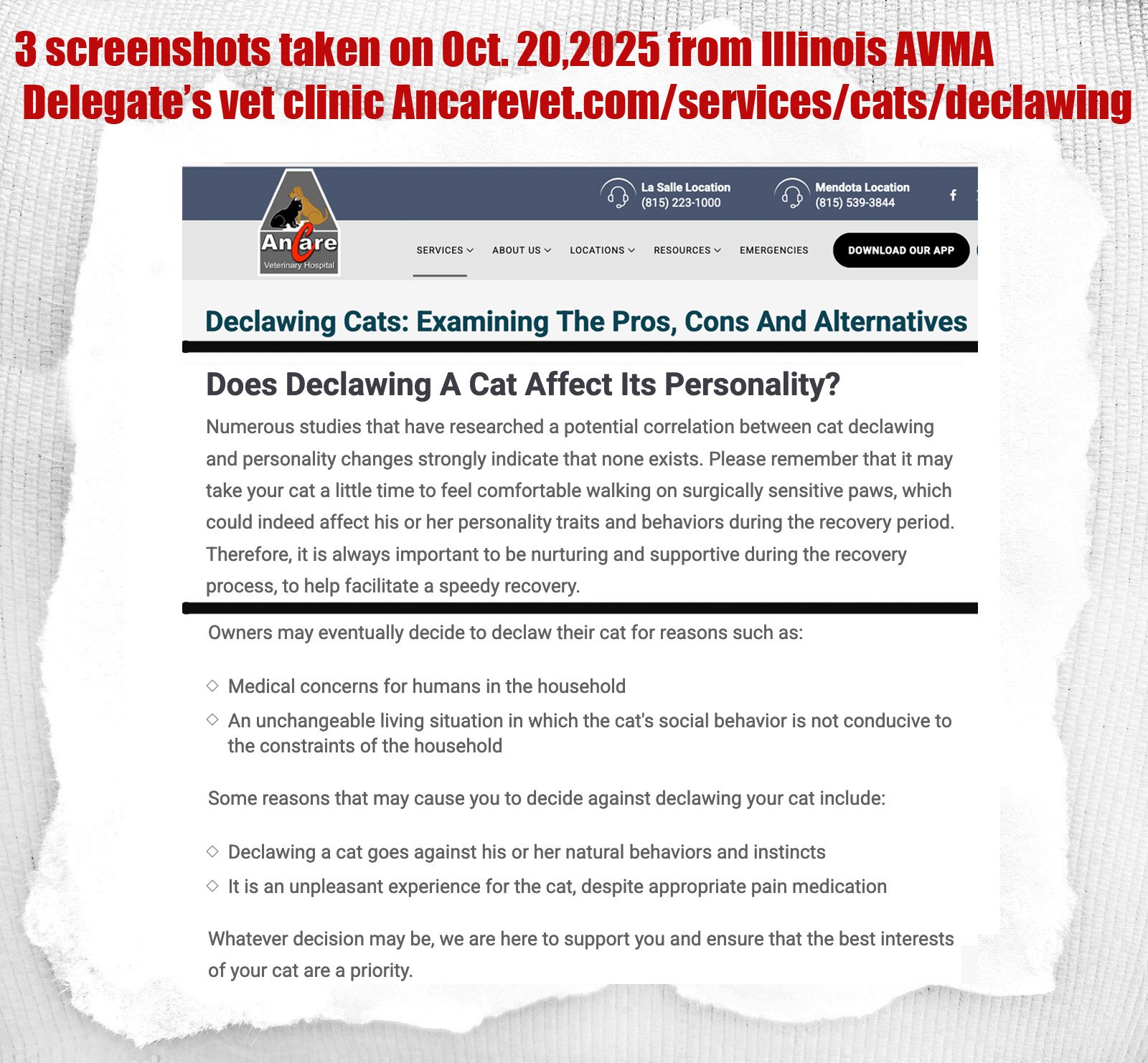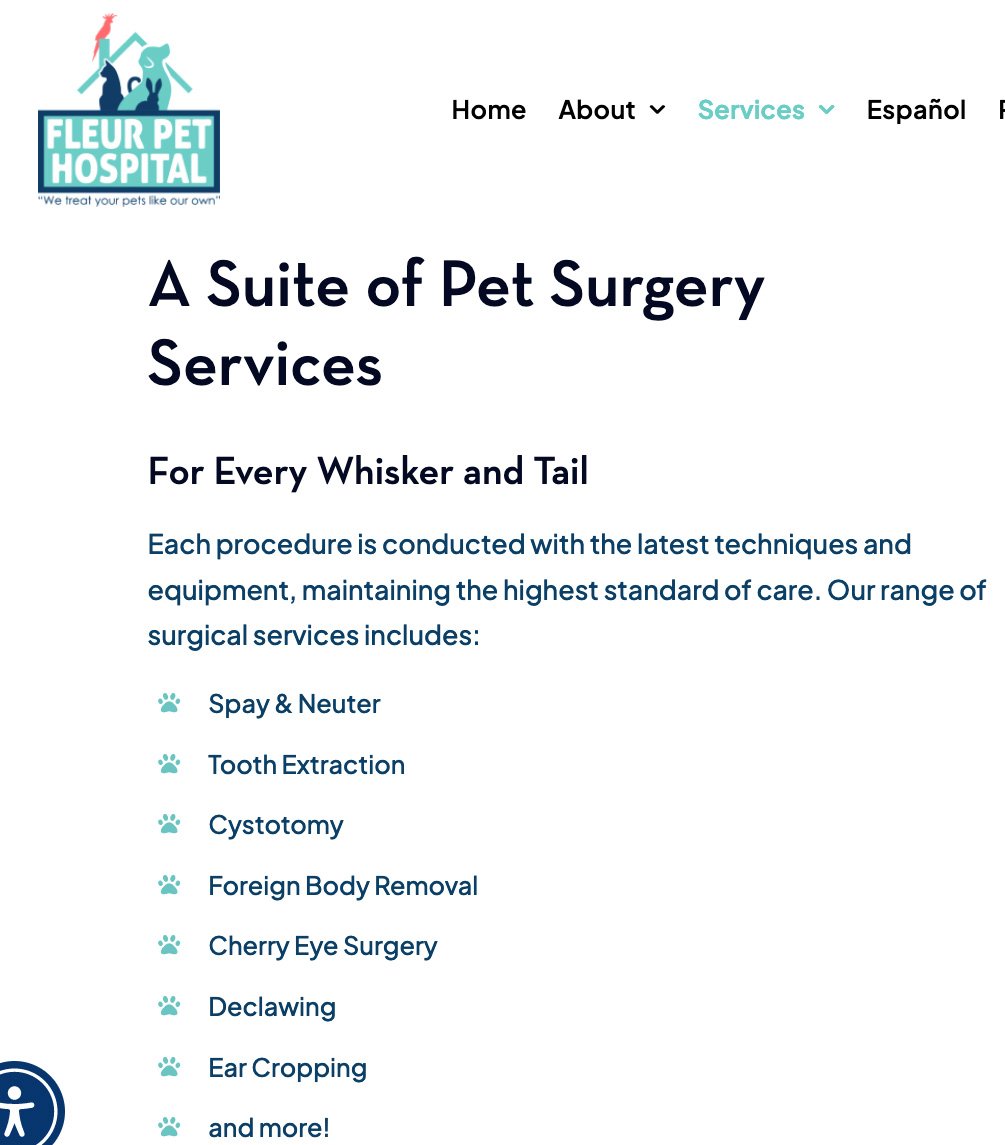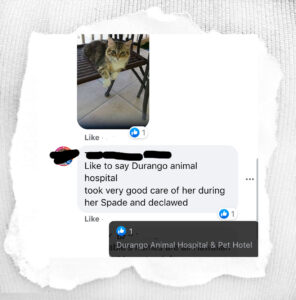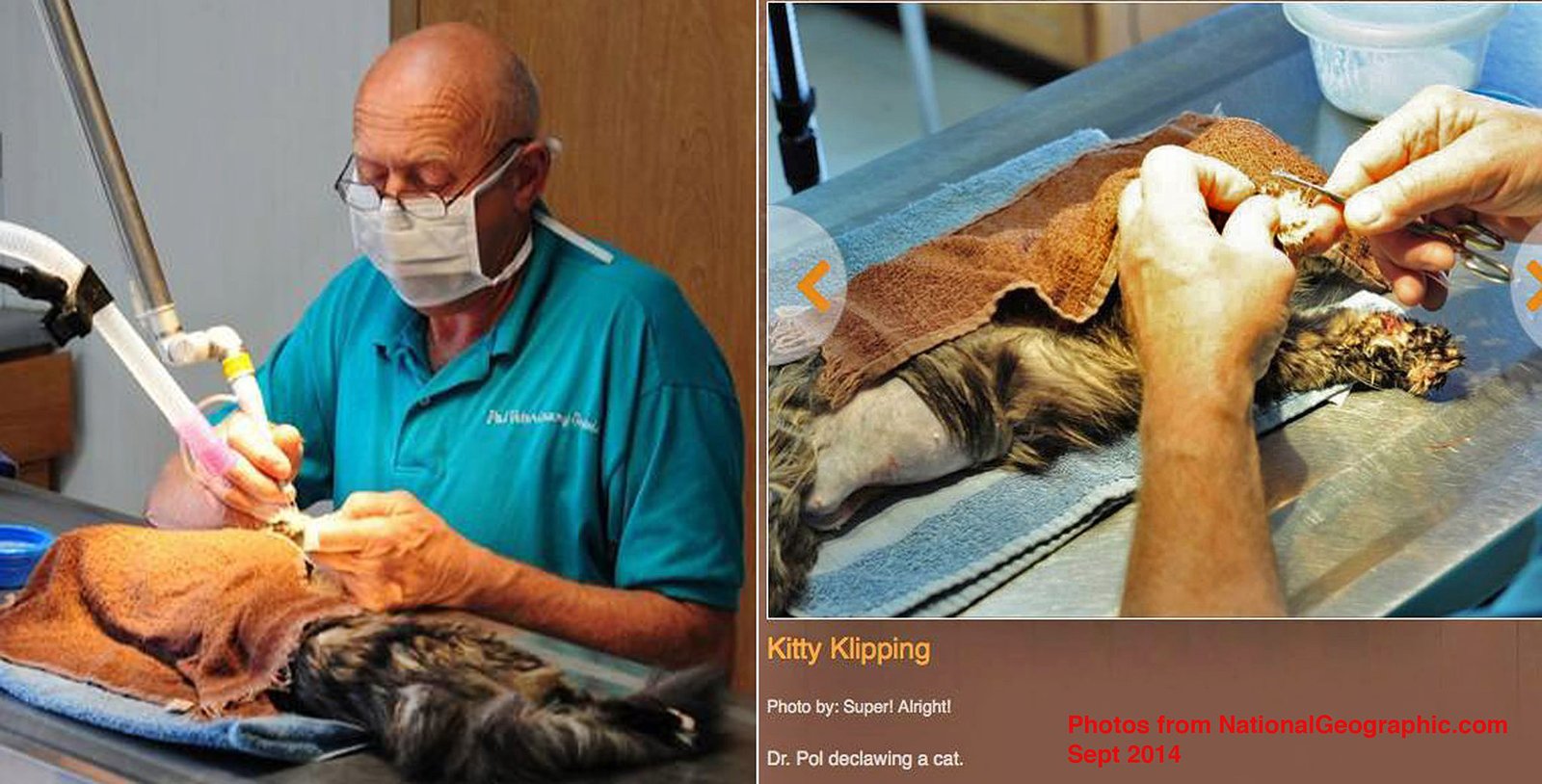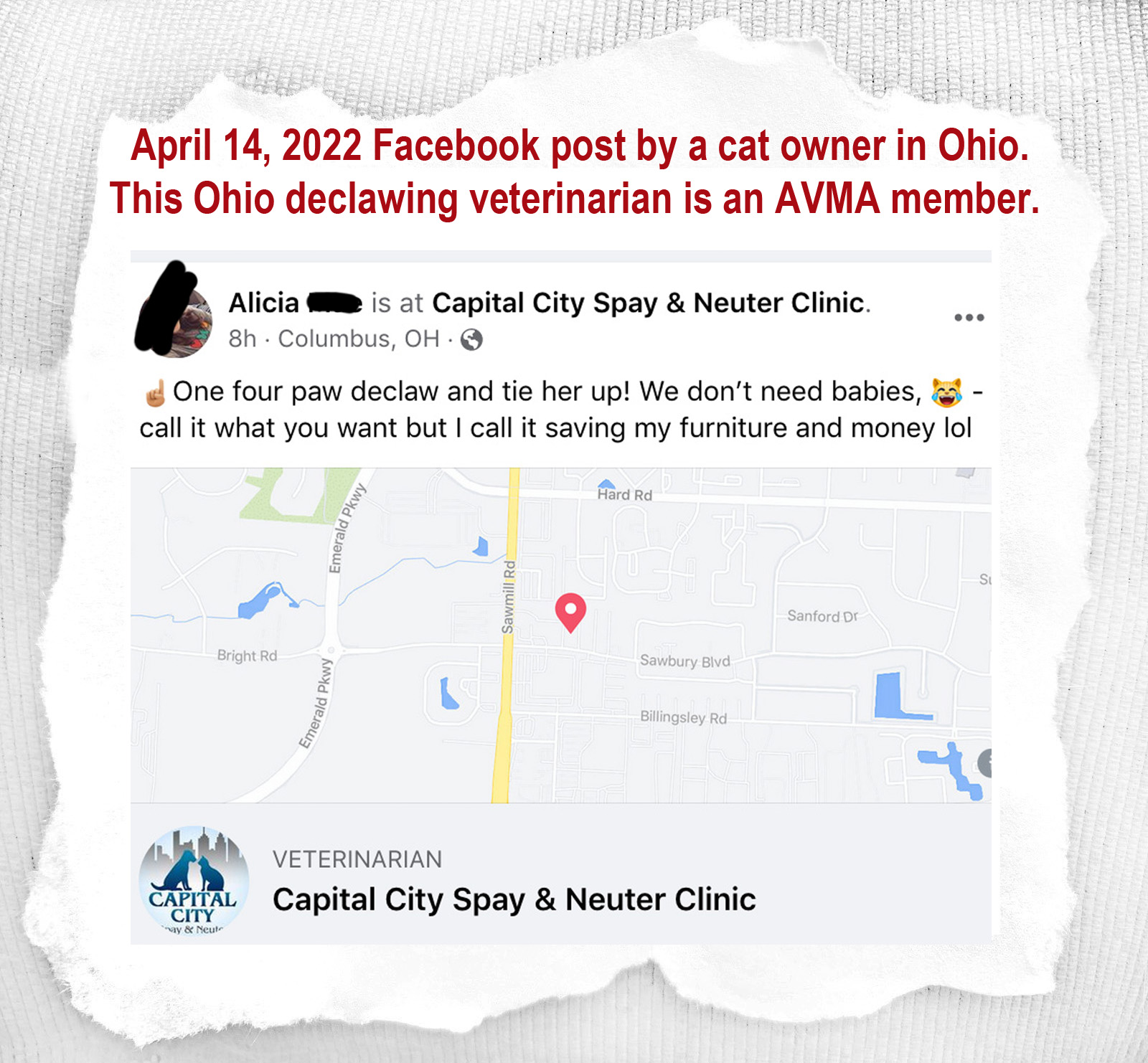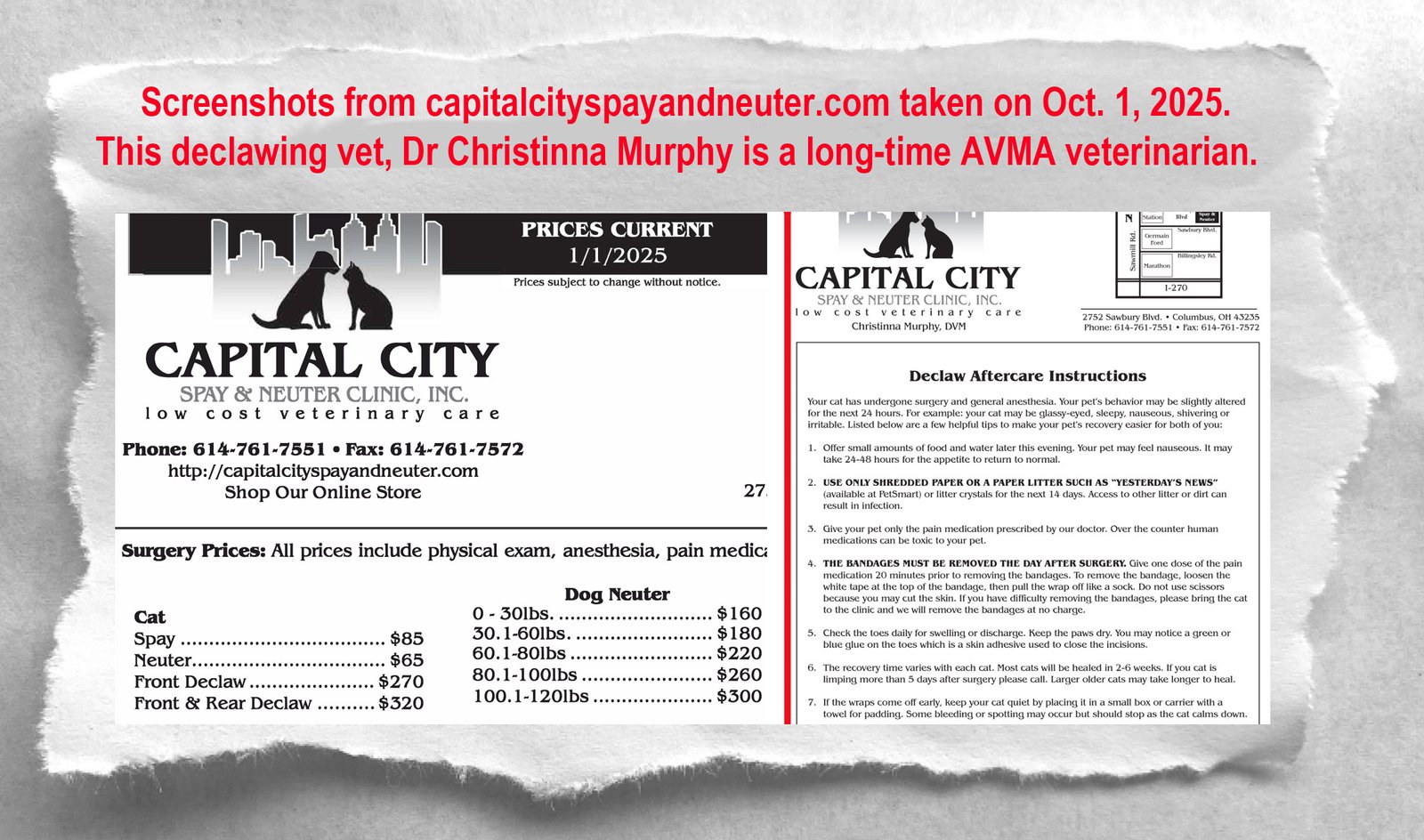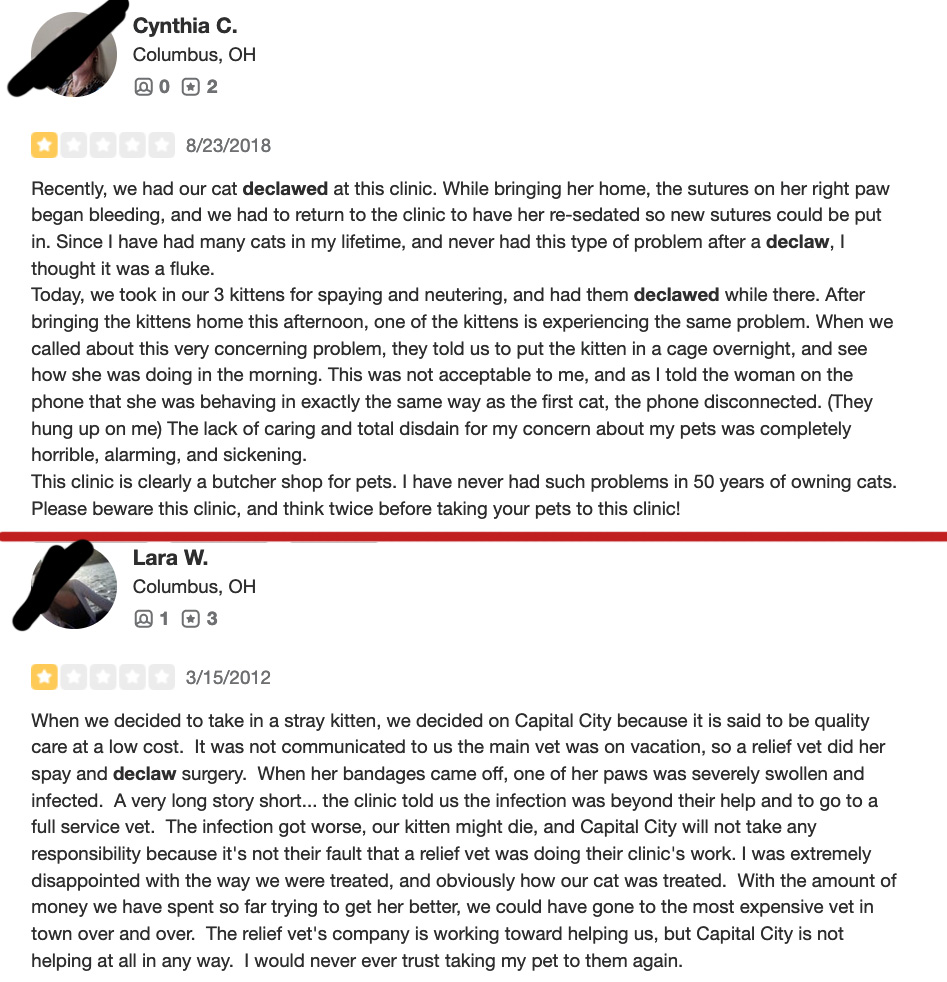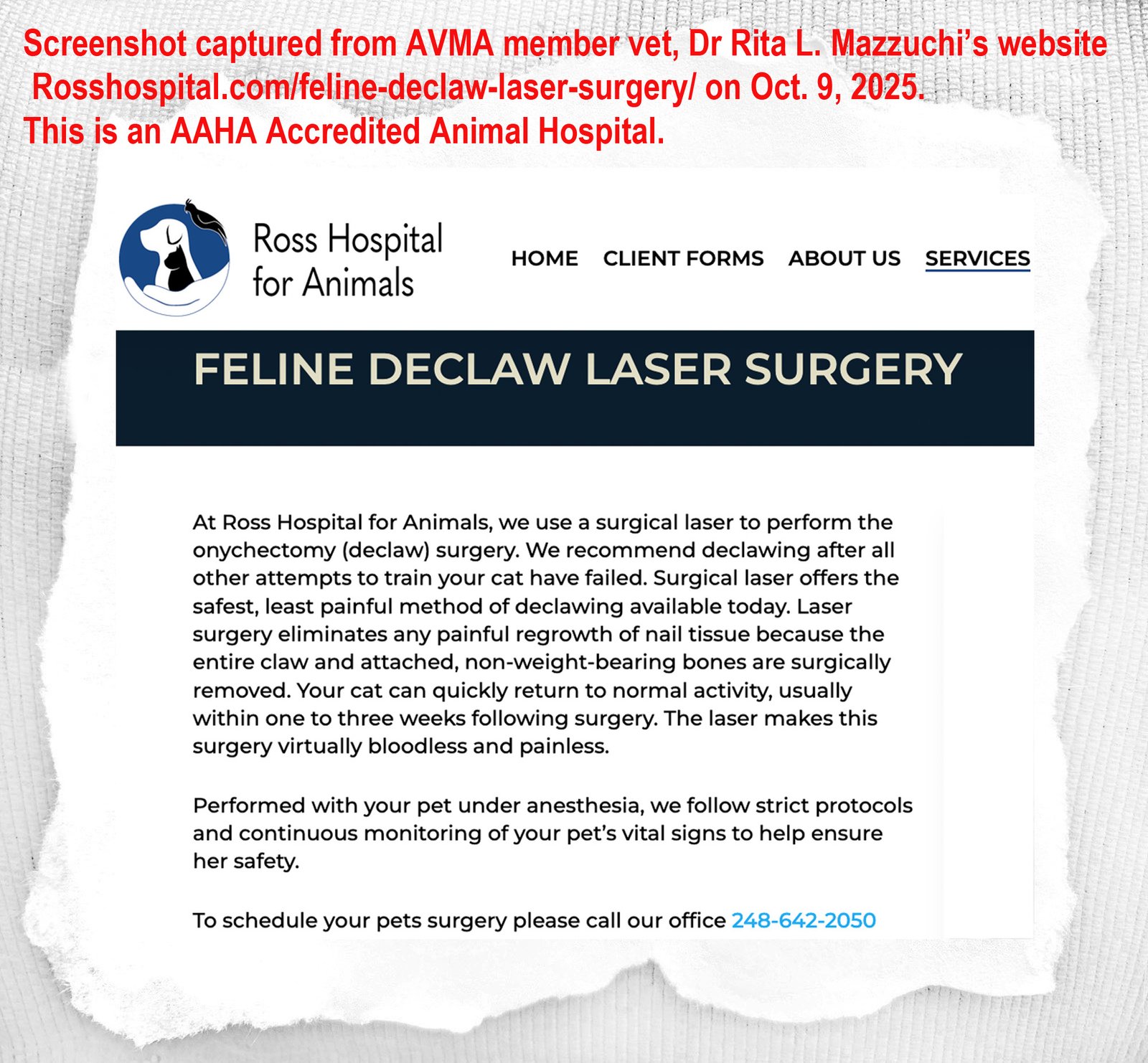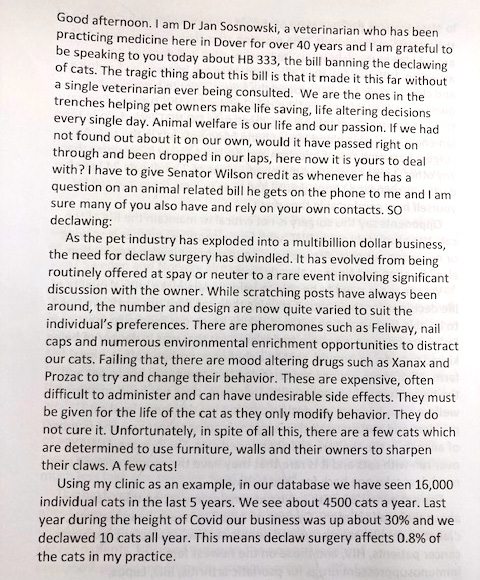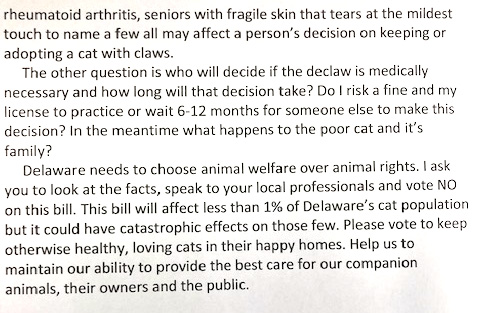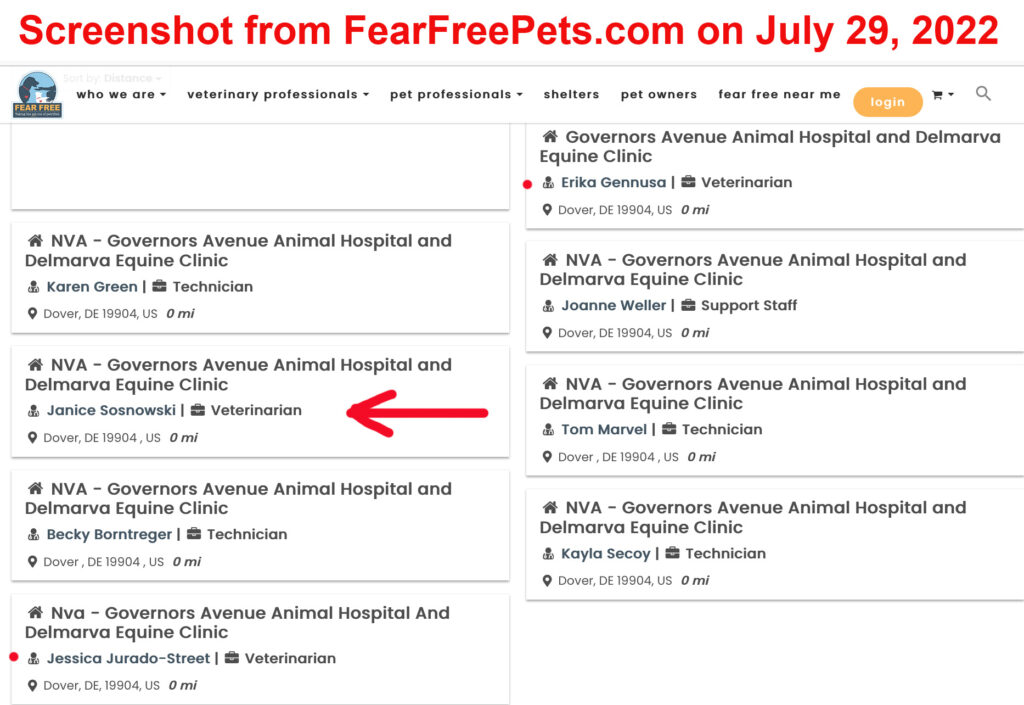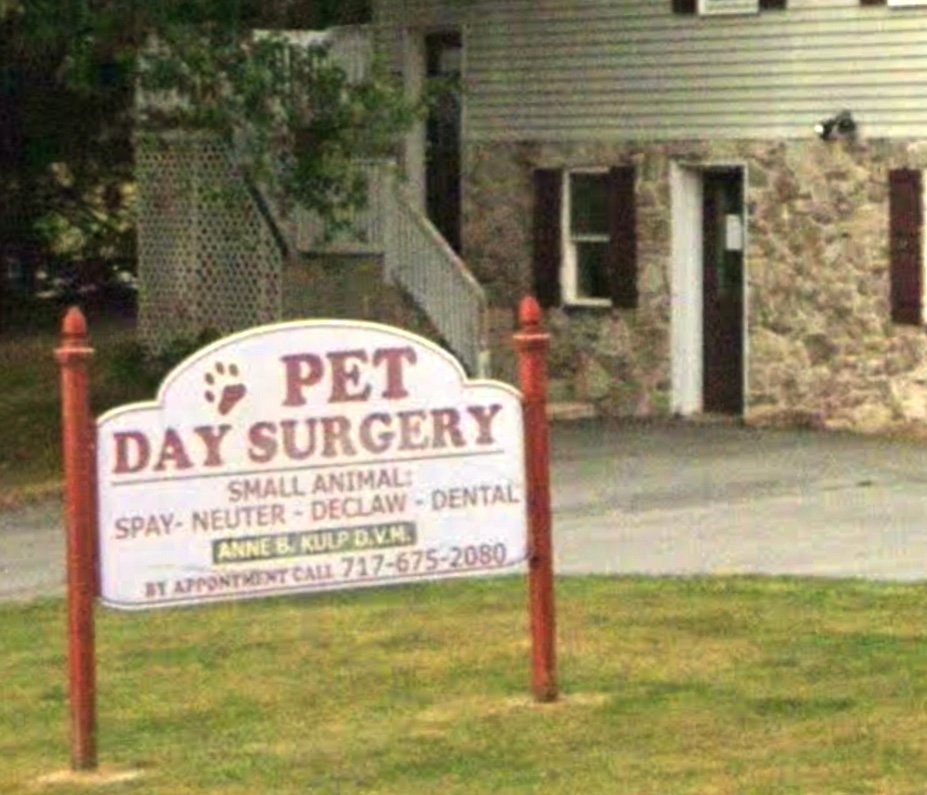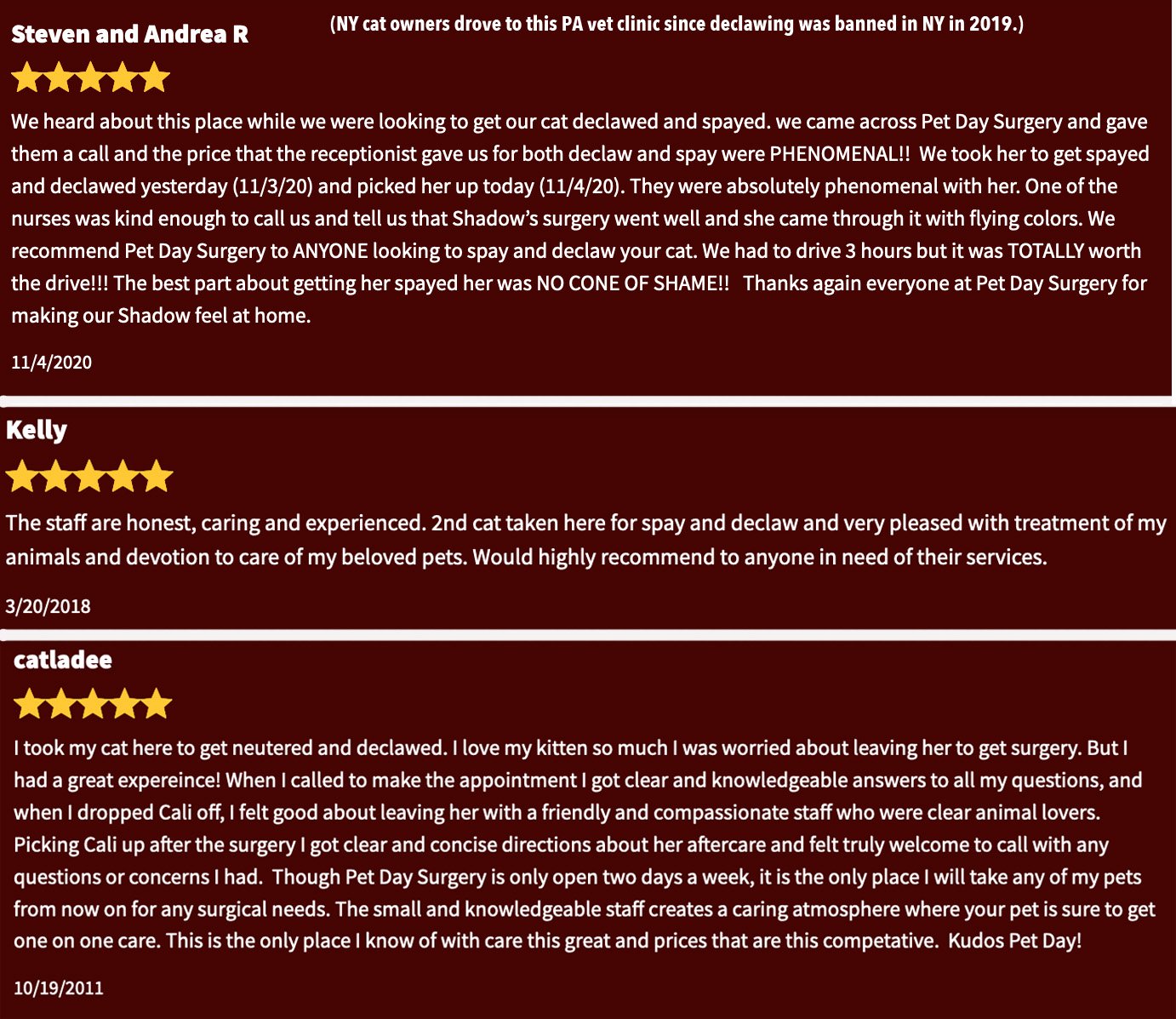Story published on October 21, 2025. (Petition to the AVMA. AVMA Petition
The American Veterinary Medical Association (AVMA), touts itself as “ethical, science-based, and animal-focused,” yet its actions tell a very different story.
The American Veterinary Medical Association (AVMA), a trade organization dedicated to advancing the interests of its member veterinarians, is under fire as evidence reveals that AVMA Delegates with direct financial ties to declawing clinics, those who profit from this cruel procedure, or whose clinics refer clients to AVMA member veterinarians that perform declawing, are the ones influencing the organization’s declawing policy.
Despite overwhelming scientific evidence and ethical consensus that declawing is an act of mutilation causing pain, behavioral issues and lifelong harm, the AVMA refuses to fully condemn it, stating in its new position: “The AVMA respects the veterinarian’s right to use professional judgment when deciding what is necessary and appropriate to best protect their individual patients’ health and welfare.”
But declawing never protects a cat’s health or welfare — it destroys both.
Even worse, AVMA delegates and members have repeatedly lobbied to block state and local anti-declawing legislation across the country—spreading misinformation, fear, and false claims to lawmakers to protect their profits and preserve the status quo. These actions directly contradict the AVMA’s stated mission to advance animal welfare and expose a deep ethical failure within the organization: choosing financial and professional convenience over the health, safety, and dignity of the very animals AVMA veterinarians are sworn to protect.
The AVMA’s new 2025 position—defending declawing under the guise of respecting veterinarian’s “professional judgment” in deciding what’s best for their patients—stands in stark contrast to overwhelming scientific evidence showing the procedure causes lasting pain and harm. The policy exposes an organization where greed and power have overtaken ethics, compassion, and science.
In a stunning example of hypocrisy, the AVMA’s 2026-27 President-Elect, Dr. Robert Knapp, advertises declawing on his clinic’s website, with language that normalizes the cruelty: “Declaw with laser (front feet only)” and “We will declaw the front feet of indoor only cats.” This messaging falsely implies that amputating only the front toe bones and claws, or using a laser, makes the procedure acceptable and safe for cats. It does not. Laser declawing a cat’s front feet is still the amputation of each toe’s last bone, a mutilating, inhumane, and painful procedure that causes permanent harm to a cat’s health and well-being.
Staff at Knapp Veterinary Hospital in Columbus, Ohio, confirmed that declawing is performed “all the time” and “Monday through Friday” by all four veterinarians, including Dr. Knapp himself. A spay/declaw costs $680–$720, and a declaw alone runs $416.97–$455.
By contrast, we found that only around 25% of veterinary clinics in Columbus, OH still perform declawing, with the majority having stopped because they state it is inhumane, cruel, and harmful to cats. This stark divide highlights how ethical veterinarians follow current science and refuse to perform this cruel procedure, while others continue declawing to reap profits, with many declawing clinics openly claiming that declawing is ok for cats.
In a further display of ignoring scientific consensus, Dr. Elizabeth Boggier, owner of MountainView Veterinary Hospital in Denville, N.J., serves as the AVMA’s New Jersey Delegate and Vice President-Elect (2026–2028). Her clinic performs declawing under vague claims of “medical necessity,” with staff citing reasons such as owners with thin skin, those on blood thinners, or hospice situations.
These are human health excuses, not veterinary ones and they directly contradict global medical and veterinary consensus. The CDC, WHO, NIH, U.S. Public Health Service, Canadian Medical Association, AAHA, ASPCA, VCA, Feline VMA, and other leading organizations all agree that declawing cats owned by people with health issues is not recommended. Experts warn that declawing offers a false sense of security and can actually increase risks, as declawed cats are more likely to bite or avoid the litter box. Hygiene, nail caps, and safe handling protect people, not amputating a cat’s toes.
The AVMA’s President-elect, VP Elect, Delegates, and members that declaw cats highlight the core of the problem: veterinarians who profit from declawing still sit at the policy table, ensuring the AVMA protects revenue streams rather than speaking for cats.
LIES and MISINFORMATION TO STOP THE DECLAWING BANS
Over the years, AVMA delegates and members have testified before legislators, using misinformation and fear tactics to block declawing bans.
Here are just some of the many examples:
2016- New Jersey delegate/AVMA member, Dr. Mike Yurkus lied to legislators and said, “It is incorrect that the last bone of the finger is removed. It is the nail bed. The claw bed is removed and the tendons are detached. Bone is not removed” and made other false claims. The bill did not pass.
2021- Wyoming AVMA member vet, Dr Peter Pelissier, owner of AAHA Accredited Mountain View Veterinary Hospital, testified to the Sheridan, WY city council against the anti-declawing ordinance and said that CA (not true since CA banned declawing in Oct. 2025) and NY banned declawing and said (6.15 minute mark), “it’s not implementing well” and questioned how the declawing laws will be enforced and gave other misinformation to the city council. There are no issues with any of the anti-declawing laws. This ordinance did not pass.
2022- Arizona AVMA member Dr. Wayne Anderson told AZ legislators that his clinics rarely declaw cats, despite 21 of 22 regularly doing so, he downplayed humane options, said the Humane Society refers his clinics declaws which was categorically false, and he gave more misinformation to legislators. The bill did not pass. (Anderson sold his AzPetVet clinics and they are now Lovet Pet Healthcare clinics and most of them are still regularly declawing cats.)
2023- New Hampshire AVMA delegate Dr. Jane Barlow told legislators that banning declawing would cause veterinarians “emotional harm” and compared declawing to a nose job. The bill did not pass.
Many long-standing AVMA member veterinarians continue to routinely declaw cats, with some openly advertising the cruel procedure and others neglecting to provide post-surgical pain medication.
Here are just some of the many examples:
Celebrity vet Dr. Jan Pol and his Michigan Pol Veterinary Services clinic declaw cats. Dr Pol Petition.
Dr. Rita Mazzuchi’s AAHA hospital in Michigan advertises her laser declaw as “painless.”
Dr. Jim Clark, Jefferson County Animal Hospital in Waurika, OK does not use pain meds for his declaws.
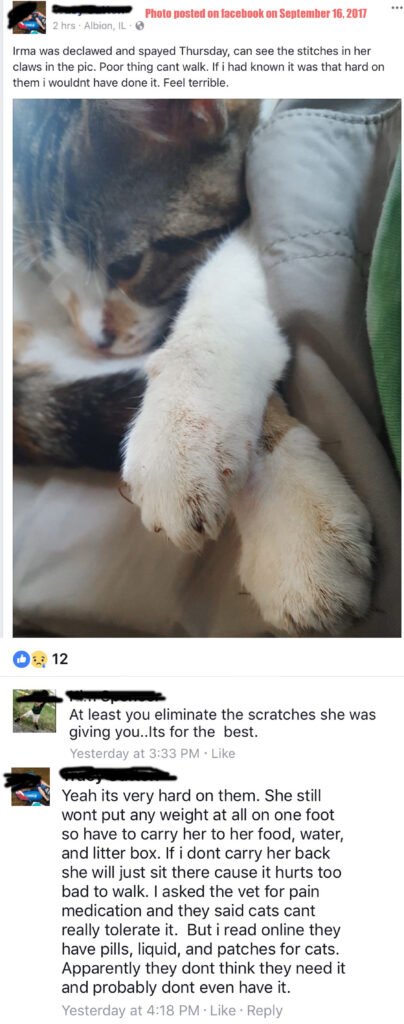
The AVMA and state veterinary associations stand alone in defending the cruel practice of cat declawing, while no animal welfare organizations support it. On Oct. 13, 2025, the ASPCA, the final holdout, removed its “declawing prevents euthanasia” excuse, marking a historic victory for feline welfare.
Read the full ASPCA story:https://citythekitty.org/feline-history-made-on-oct-13-2025-aspca-dumps-dangerous-declaw-death-defense-held-since-2016/
Background
2012. The AVMA condemns exotic cat declawing.
Declawing exotic cats brings little to no income to veterinary clinics, so in 2012, the AVMA had no problem completely “condemning” the practice outright, citing “concerns that pain and suffering associated with declawing may be exacerbated” in exotic cats and “Other than for medical reasons that would clearly benefit the animal, there appears to be no justification for performing the procedure in this population of cats.”
Domestic cats are another story.
Declawing domestic cats still generates easy and steady revenue for many AVMA members, Delegates, and leaders. This reality helps explain why, despite decades of evidence that this brutal amputation procedure causes chronic pain, arthritis, behavioral issues, abandonment, and euthanasia, the AVMA refuses to completely condemn it.
For example, this August 2025 Université de Montréal Declawing Study found that:
Declawed cats suffer more pain than cats with arthritis
Only declawed cats showed signs of nerve damage
Declawed cats had worse mobility and sensitivity to touch
Declawed cats had permanent signs of chronic pain
Declawed cats experienced greater functional impairment
Pain was persistent and long-term, even years after surgery
This pattern, condemning exotic cat declawing where no money is at stake while protecting it where profits flow with domestic cats even though read data shows how inhumane, cruel and harmful it is, exposes the AVMA’s true priorities. While the AVMA claims to stand for science and animal welfare, its actions show loyalty to revenue and membership protection comes first.
“It’s a clear double standard,” said City the Kitty nonprofit. “If declawing is cruel and completely unacceptable for a 8 pound exotic cat, the same should be said for an 11 pound house cat. The pain, cruelty, and short and long term suffering don’t change just because the cat lives in someone’s home instead of in a sanctuary.”
——————————————————————————————————————————————————–
The financial conflict of interest is woven into the AVMA’s structure. The organization represents more than 108,000 veterinarians and relies on their dues.
Many AVMA delegates, who help shape the association’s declawing policy, either actively perform this cruel procedure or are affiliated with clinics that perform it.
In July 2025, delegates voted on a proposed update that would have acknowledged declawing “often results in chronic pain,” opting instead for language that it “may result.” Texas delegate Dr. Bridget Heilsberg defended the softer wording as “more defensible.”
If the AVMA had chosen the word ‘often,’ countless cat owners could have been better informed about the high likelihood of serious risks from declawing and most would likely have chosen humane alternatives instead. But by keeping the weaker wording, the AVMA and its declawing veterinarians are doing everything they can to protect the steady stream of revenue this cruel practice brings to their practices, even at the expense of the welfare of cats.
Despite admitting declawing “may result in chronic pain, maladaptive behavior, disability, and significant mutilation,” the AVMA rejected stronger 2025 policy language, shielding profits.
AVMA leadership has even admitted its policies are crafted with veterinarians’ financial interests in mind. In 2017, then-Board Chair Dr. Mark Helfat told JAVMA News this, “I would point out as well that some of these policies are used in our advocacy efforts to support the best interests of our 90,000 members. A perfect example is the AVMA policy on soring,…. I similarly would point to the AVMA policy on feline declawing as an example of where we stand as an Association on this topic and why we are opposed to various legislative initiatives as of late.
When Helfat named declawing as a prime example of member-serving policy in 2017, he made clear what critics still argue today: the AVMA defends declawing not because the science is uncertain, but because it remains profitable for its members.
Meanwhile, veterinary associations across Europe and Canada have declared declawing inhumane, unethical, and an act of mutilation. Eight of nine Canadian provinces have banned it outright, and most countries worldwide have either outlawed the practice or do not perform it.
The Canadian Veterinary Medical Association completely condemned declawing in 2017 after more data came out about how declawing harms cats and said it is “unacceptable as it offers no advantage to the feline” while the AVMA posted a story with their 2017 President, Dr Mark Helfat, admitting that some of the AVMA’s policies like declawing are used in their advocacy efforts to support the best interests of its member veterinarians and are opposed to banning it.
—————————————————————————————————————————————
Over the years, AVMA member veterinarians and AVMA delegates have played a central role in blocking anti-declawing legislation across the U.S.
Here are some of the many examples:
New Jersey 2016 anti-declawing bill: AVMA member and Delegate and 2018 President of the New Jersey Veterinary Medical Association, Dr. Mike Yurkus, blatantly lied in his testimony to legislators when he said, “It is incorrect that the last bone of the finger is removed. It is the nail bed, the claw bed is removed, and the tendons are detached. Bone is not removed, we do not cut bone.”
Actually declawing always involves removing the last bone in the cats paws and is an amputation of the bone.
Dr Yurkus also said there are no studies that associate declawing with any long term behavioral problems, and told other lies to legislators. The bill did not pass. In 2023 Yurkus became the NJ Alternate Delegate for the AVMA.
Sheridan, WY 2021 anti-declawing ordinance: AVMA member vet, Dr Peter Pelissier, from MountainView Veterinary Hospital, testified to city council members and gave false information, including saying said that CA and NY have a statewide declaw ban, and said it’s not implementing well and asked how are you going to enforce that. That is NOT accurate as declawing was not illegal in the state of CA in 2021 and the ban in NY state does not have any issues with enforcement. (One of the City Council members told us that he voted against the ordinance because of Dr Pelissier’s testimony. )Video of how an AAHA Vet Fought to Keep Cruelty Legal According to an employee in March of 2025, who works at Mountain View Veterinary Hospital, they regularly perform front declaws and a declaw/neuter is $850-$900.
Arizona 2022 anti-declawing bill. AVMA veterinarian Dr Wayne Anderson, AzVMA’s Advisory Council Board Member, testified to the Arizona legislators against this AZ bill with blatant lies and misinformation.
New Hampshire 2023 anti-declawing bill. AVMA delegate Dr. Jane Barlow testified to legislators that banning declawing would cause “emotional harm” to veterinarians who perform it, compared declawing to a nose job, and said declawing “does not rise to the level of animal cruelty.”
Here’s Dr Barlow’s testimony to the House committee at the 4.08.25 sec. mark where she said that banning declawing will cause harm to veterinarians and in the Senate committee at the 1 hr 4 minute mark where she compared declawing to a nose job and that it isn’t animal cruelty.
——————————————————————————————————————————————————-
AVMA Declawing Policy Revisions and Advocacy Efforts Against Declawing Legislation
2003: The AVMA 2003 position expanded its one-sentence statement to encourage client education about scratching behavior and to outline surgical risks.
In their 2003 position, the AVMA also stated this without scientific data to support it:“Scientific data do indicate that cats that have destructive clawing behavior are more likely to be euthanatized, or more readily relinquished, released, or abandoned, thereby contributing to the homeless cat population. Where scratching behavior is an issue as to whether or not a particular cat can remain as an acceptable household pet in a particular home, surgical onychectomy may be considered.”
2007. The AVMA actively tried to stop the anti-declawing legislation in West Hollywood and wrote this in JAVMA about it: “The AVMA has been assisting the CVMA through the appeals process, and AVMA President Gregory S. Hammer recently wrote to encourage the California Supreme Court to review the case. If the appellate court’s decision is allowed to stand, it would have a profound impact on the regulation of veterinary medicine in California as well as nationwide, according to Dr. Hammer. “If upheld, the West Hollywood declawing ordinance will become precedent for thousands of local government units to consider restricting not only cat declawing, but potentially a variety of other veterinary procedures as well.” Ah, the old, if you ban declawing, what other procedures will you ban excuse.
2008. Here are some quotes from the AVMA’s Dr Gail Golab, Associate executive vice president / Chief veterinary officer, in a 2008 NBC story, “But the declawing surgery, while common, “has slowly been considered less acceptable” in recent years, says Gail C. Golab, director of animal welfare for the AVMA. Anti-declawing activists say the procedure often causes cats to refuse their litter boxes. But “there’s not a cause and effect relationship that’s been demonstrated there,” says Golab.” “In a situation where either the cat goes or the claws go, there’s so much at this point in terms of improved surgical technique, with laser surgery and with pain control, that you really can do the procedure with a minimal amount of discomfort to the cat,” says Golab. “I don’t think there’s any comparison between cats enjoying a life in a household and putting them in a shelter to avoid declawing.”
2009: Policy revisions emphasized opposition to municipal bans on licensed veterinary procedures, including declawing.
2014: The AVMA’s Declawing Policy was revised to include the language that declawing (onychectomy) is an “amputation” and “should be regarded as a major surgery.” The policy still used the euthanasia excuse, ““Scientific data do indicate that cats that have destructive scratching behavior are more likely to be euthanized, or more readily relinquished, released or abandoned, thereby contributing to the homeless cat population,” the policy stated.
2017: Comment from the AVMA about declawing bans in their newsletter.
(This is a myth. Declawing does not prevent euthanasia and many declawed cats lose their homes because of the behavioral issues they develop from the pain and discomfort in their mutilated paws. Our section 4 and 10 have all the data and facts about this issues.)
2019. The AVMA wrote this in their AVMA Journal about the 2019 anti-declawing bill in NY state. “New York state now joins a short list of cities that prohibit what critics claim is an unnecessary and inhumane surgery. Veterinary organizations, including the AVMA and New York State Veterinary Medical Society, say the procedure should remain an option when the alternative is abandonment or euthanasia.”
2019- AVMA’s Literature review on the welfare implications of Declawing of Domestic Cats pdf. https://www.avma.org/sites/default/files/resources/declawing_bgnd.pdf
January 2020: The AVMA took out the euthanasia excuse from their declawing position as experts in feline behavior from the Feline VMA, VCA, and Banfield since current evidence does NOT support it. Here’s the link to Banfields and the Feline VMA’s positions.
Here’s a story in JAVMA in Feb. 2020 about the revisions and an excerpt from the March 1, 2020 JAVMA newsletter, “The Banfield policy states that “Current evidence does not support the use of elective declawing surgery as an alternative to relinquishment, abandonment, or euthanasia.”
Here’s the AVMA’s 2020 Declawing Policy.
2022. The AVMA actively opposed the MD anti-declawing bill and submitted this letter of opposition. Here’s an excerpt from the letter. “Good animal health and welfare is supported by the veterinarian’s ability to apply professional judgment within the context of the veterinarian‐client‐patient relationship
The adoption of SB 67 would circumvent the professional judgment of Maryland veterinarians and disrupt the veterinarian‐client‐patient relationship, which has long been the foundation of veterinary medical practice. Best health and welfare outcomes for veterinary patients, clients, and the public require that decisions involving the diagnosis and treatment of veterinary patients—including the
performance of surgical procedures, such as declawing—be made by the animal’s veterinarian in consultation with the animal’s owner. This ensures that each animal receives the best possible care that is uniquely tailored to its needs. Veterinarians must retain authority to exercise professional judgment in making clinical recommendations that are in the best interest of their patients.” – Janet D. Donlin, DVM, CAE. Executive Vice President and Chief Executive Officer.” (This bill passed and Maryland became the 2nd state that banned declawing.)
July 2025: The AVMA’s latest declawing policy continues to side with veterinarians who perform the surgery rather than with cats.
This comes despite decades of evidence showing the procedure causes chronic pain, behavioral problems, higher rates of relinquishment, and often abandonment or euthanasia — while jurisdictions that have banned declawing have not seen higher shelter intake.
In June 2025, the AVMA Board of Directors proposed strengthening its language to say declawing “often results in chronic pain.”
At the July House of Delegates meeting, Dr. Colleen Currigan, FelineVMA delegate and feline expert, urged delegates to keep “often.”
“A growing body of evidence shows declawed cats suffer chronic pain that owners and even veterinarians frequently miss,” Currigan said. “Using ‘often’ reflects what science is beginning to document.”
But other members countered the data remain limited and warned that “often” could overstate the evidence. Texas alternate delegate Dr. Bridget Heilsberg, an equine veterinarian, argued that “may” was “more defensible.” Delegates voted with her, keeping the weaker phrasing.
As a result, the AVMA still claims declawing “may result in chronic pain, maladaptive behavior, disability, and significant mutilation.” The policy discourages but does not forbid the practice — a stance critics say protects revenue streams for declawing veterinarians over the welfare of cats.
Advocates ask why the AVMA refuses to include evidence-based facts: that declawing itself increases the risk of behavioral issues, relinquishment, and abandonment, and that in regions where the surgery is banned, shelter surrenders and euthanasia rates have not risen.
Here’s our story and rebuttal of the AVMA’s 2019 Declawing Position.
———————————————————————————————————————————————————–
Declawing Was Invented in 1950
Declawing started in the 50’s by an AVMA vet, Dr Grant Misener. There were no studies on how this amputation procedure would affect a cat’s health and well-being done before the AVMA started promoting it to the profession.
The AVMA celebrated him as a doctor who invented a “humane procedure to declaw cats.” Here is what the AVMA said about Dr Grant Misener in his obituary on the AVMA website.
Here is a letter to the editor from Dr Grant Misener in 1952 in the AVMA’s journal, JAVMA.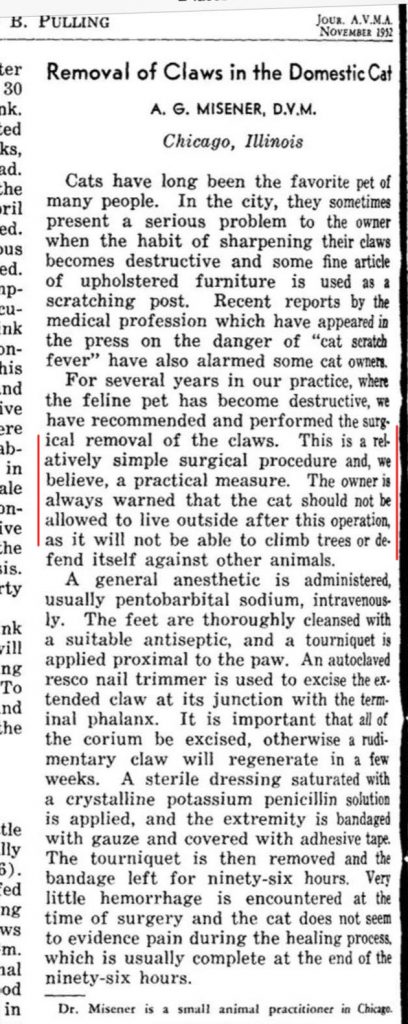
This is the Resco nail trimmer tool that many vets still use to amputate the toe bones on a cat and that the AVMA calls “humane.” They put the cat’s toe bone inside the cutting part of it and crush off the bone. 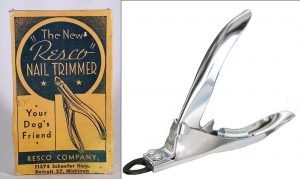
These are the toe bones that were declawed with a guillotine clipper as you can see many of them only have a part of the P3 bone amputated which means the cats will have a life with even more pain and suffering from the bone fragments in their mutilated paws.
Here is just one of the sad stories about the millions of cats who have been horrifically declawed by this rescoe trimmer method. Declawed cat story
Scientific consensus
Declawing amputates the last bone of each toe, comparable to removing the tips of human fingers. Studies show high rates of chronic and long term pain, arthritis, litter box avoidance, and aggression. Here are all the facts about declawing with the studies to back them up.
Countless studies show how inhumane, cruel, and harmful declawing is for a cat. Even the AVMA says in their 2025 declawing position, “The amputation or other surgical alteration of the distal digits is an acutely painful procedure and may result in chronic pain, maladaptive behavior, disability, and significant mutilation.”
Veterinary associations in Canada and Europe have completely condemned the practice.
Where science ends and vested interests begin
The AVMA says they strongly discourage declawing but our random survey of AVMA delegates shows many perform declaws regularly or refer clients to clinics that do. One delegate admitted her clinic declaws cats “routinely,” offering package prices as low as $284.97 for a neuter/declaw. She even acknowledged to a caller that “studies show 40% can develop chronic arthritis,” yet the clinic continues to perform the procedure “if needed.”
Critics say these examples reveal how organized misinformation, blatant lies, and fear tactics, not science, have kept declawing legal in much of the U.S.
Pattern of profit protection
At the 2015 AVMA convention, a continuing education course was marketed to veterinarians with the selling point of “improved hospital revenue” through declawing.
The bottom line
Despite 20 years of policy revisions, the AVMA continues to avoid an outright condemnation of declawing domestic cats.
The message is clear: the AVMA exists to protect veterinarians’ financial interests, even when the cost is borne by cats.
While the American Veterinary Medical Association (AVMA) has resisted fully condemning declawing and admits their declawing policy is used in their advocacy efforts to support the best interests of their thousands of members.
All the other veterinary organizations and associations completely condemn declawing, including the biggest one in the world, the Federation of Veterinarians of Europe.
The FVE fully supports the 1987 European Convention for the Protection of Pet Animals which says: Surgical operations for the purpose of modifying the appearance of a pet animal or for other non-curative purposes shall be prohibited and, in particular: Docking of tails, Cropping of ears, Devocalisation, and Declawing and defanging.
-
2017: The Canadian Veterinary Medical Association (CVMA) formally declared its opposition to feline declawing (onychectomy), stating the practice causes “unnecessary and avoidable pain” and is not in the best interest of cats.dhealkdjgoo
- CVMA’s 2017 position. “The CVMA position statement now says, “Veterinarians strive to use their scientific knowledge to promote animal health and welfare and relieve animal suffering in keeping with the principles of veterinary medical ethics. With or without concrete scientific evidence, ethical consideration has to be given to the welfare of the animal. Veterinarians need to consider what advantages non-medically driven PDAs offer to the feline. Viable alternatives to PDAs exist. Therefore, from an ethical viewpoint, the CVMA views this surgery as unacceptable as it offers no advantage to the feline and the lack of scientific evidence leaves us unable to predict the likelihood of long-term behavioral and physical negative side effects.”
-
2018–2023: Provincial veterinary associations and legislatures moved swiftly. Nova Scotia became the first province to ban the procedure in 2018. Other provinces followed with regulatory or legislative bans.
- 2022. The Canadian Veterinary Medical Association updated their declawing policy to reflect current data.
-
2024: By this year, eight of Canada’s nine provinces had outlawed declawing, making the country a global leader in feline welfare.
Canadian veterinary leaders framed the decision as putting animal welfare first, even if it meant some practitioners lost a source of revenue.
“Declawing is an elective amputation that serves no benefit to the cat,” the CVMA said in its position statement. “As professionals entrusted with animal care, we cannot condone it.”
The bans mean that for most Canadian cat owners, declawing is no longer an option — and scratching posts, training, and other humane solutions have become the standard.
By contrast, the AVMA’s latest policy in 2025 still only says declawing “may” cause chronic pain, leaving the decision to veterinarians and allowing the procedure to remain widely available in the U.S.
————————————————————————————————
A random survey of 13 vet clinics linked to AVMA delegates and leaders reveals a troubling pattern: many perform declawing or are tied to clinics that do, explaining the AVMA’s refusal to fully condemn this cruel practice, favoring veterinarians’ profits and support for its legality over cat welfare.
According to the vet clinic’s staff:
•9 perform declawing.
•3 of them say they do not perform declawing but they refer cat owners to declawing clinics with AVMA vets.
• One does not perform declawing, does not refer cat owners to a declawing clinic.
These AVMA member clinics openly admit to amputating cats’ toes with scalpels or lasers, charging hundreds of dollars, sometimes declawing both front and back paws, and even performing the surgery on older cats.
Staff describe the procedure as ok for indoor cats and minimize or dismiss the risk of chronic pain, despite scientific research proving the chronic pain and long-term complications.
Only one AVMA member veterinary clinic mentioned humane alternatives like scratching posts or nail caps as the preferred solution to declawing. This highlights why the AVMA avoids completely condemning this inhumane amputation procedure: its policies, shaped and voted on by delegates, often prioritize the financial interests of member veterinarians who profit from declawing over the welfare of cats.
Random Survey of some of the AVMA Leaders and Delegate’s Vet Clinics and declawing.
2026-27 AVMA President- Elect
Dr Robert Knapp. Knapp Veterinary Hospital, Columbus, OH
Link to Knapp’s surgery page with “Declaw with laser (front feet only)” listed on it. Link posted on Sept. 30, 2025. https://www.knappvet.com/general-surgery-info.pml
UPDATE. After our story was published, Knapp Veterinary Hospital took all their declawing info off their website. https://knappvet.com/general-surgery-info.pml
Dr Knapp says these things in his AVMA bio, “My goal in leadership has always been to put the needs of the profession and our members first. ” and “I am not afraid of change, nor do I shy away from controversy or from taking an unpopular stance on an issue if I believe it to be right.”
Researcher asked an employee at Knapp Veterinary Hospital for the cost of a neuter/declaw and the employee said it is $108 for the neuter and the low end of a declaw is $416.97 – $455.
Researcher asked who their declaw surgeons are and they said all their vets perform declaws and are “amazing doctors.” Their doctors use the laser for the declaw. Researcher asked if Dr Knapp does the declaws and they said he can and they have other doctors who can also do them.
Researcher asked if the cats are ok long term after a declaw and they said you need a $75 exam to discuss the details of the declaw with the doctor and after that, they could schedule the surgeries.
Researcher asked if they perform declaws regularly and the employee said, “Yes, Monday through Friday.”
Researcher asked if the laser is better for a declaw and the employee said they have heard that the laser is better but said to ask the doctor in the exam.
Researcher wanted to confirm the info and asked if their doctors perform declaws often and the employee said, “Yes, they do them all the time, yes.”
Another employee said that a spay/declaw is $680-$720 and you need a $75 exam first. They said all four of their doctors can do a declaw/spay and it just depends on what day of the week it is.
————————————————————————————————————————————————–
Dr Elizabeth Boggier, owner of MountainView Veterinary Hospital, Denville, NJ
AVMA Delegate NJ and AVMA Vice President Elect, 2026-2028
Dr Boggier’s hospital says it is a Cat Friendly/Feline Friendly Practice on their website and the Feline VMA does not allow their CFP to declaw cats for any reason except for a medical reason for the cat like a tumor or injury. https://mtnviewvets.com/feline-friendly/
This hospital also posted numerous Facebook posts this year that say they are a Cat Friendly Practice. However, MountainView Veterinary Hospital in NJ is NOT listed as a Cat Friendly Practice on https://catfriendly.com/find-a-veterinary-professional/ and the Feline VMA assured us that the information on their website is accurate.
Website Feline Friendly link with Cat Friendly Practice Logo.
Dr Boggier is listed as a “Feline VMA member” on the catfriendly.com website and this organization does not allow their member veterinarians to declaw cats.
Sept. 2025
Researcher asked for the cost of a neuter/declaw and the employee said that they do not declaw unless it is medically necessary. They said there are a lot of different kinds of medical reasons why cats would need to be declawed so it’s up to the discretion of the doctor.
Researcher asked if a reason would be if someone has thin skin and they would bleed a lot if scratched. The employee said yes. The staff member said if someone is on blood thinners and the cat was scratching them, the doctor would consider it.
They put another employee on the line who said you have to get an exam first before they would think about a neuter and declaw. They said declaws are illegal in New Jersey unless they are medically necessary. The employee gave an example and said they had a client who had a wife who was in hospice care and the cat kept clawing at her legs and the declaw was permitted in NJ because of that issue. They said it needed to be in reason and it was deemed medically necessary for the cat to be declawed and in NJ it is illegal unless there’s a medical reason for it. (Declawing is not illegal in NJ. Here’s our story.)
Researcher asked if they have a surgeon who can do the declaw if it’s medically necessary and the staff member said they have two, Dr Boggier and Dr Lynn.
The employee said it’s very rare that they do declaws in New Jersey. (Our 2023 survey of vet clinics in NJ in 2023 showed that 72% of them declaw cats.)
——————————————————————————————————————
Dr Sandra Faeh. AVMA Past President (2025) and Chief Medical Officer of National Veterinary Associates (NVA)
NVA allows declawing in their animal hospitals and lied about it to City the Kitty nonprofit after they worked with NVA to help them craft a new declawing position in 2022 and 2025. 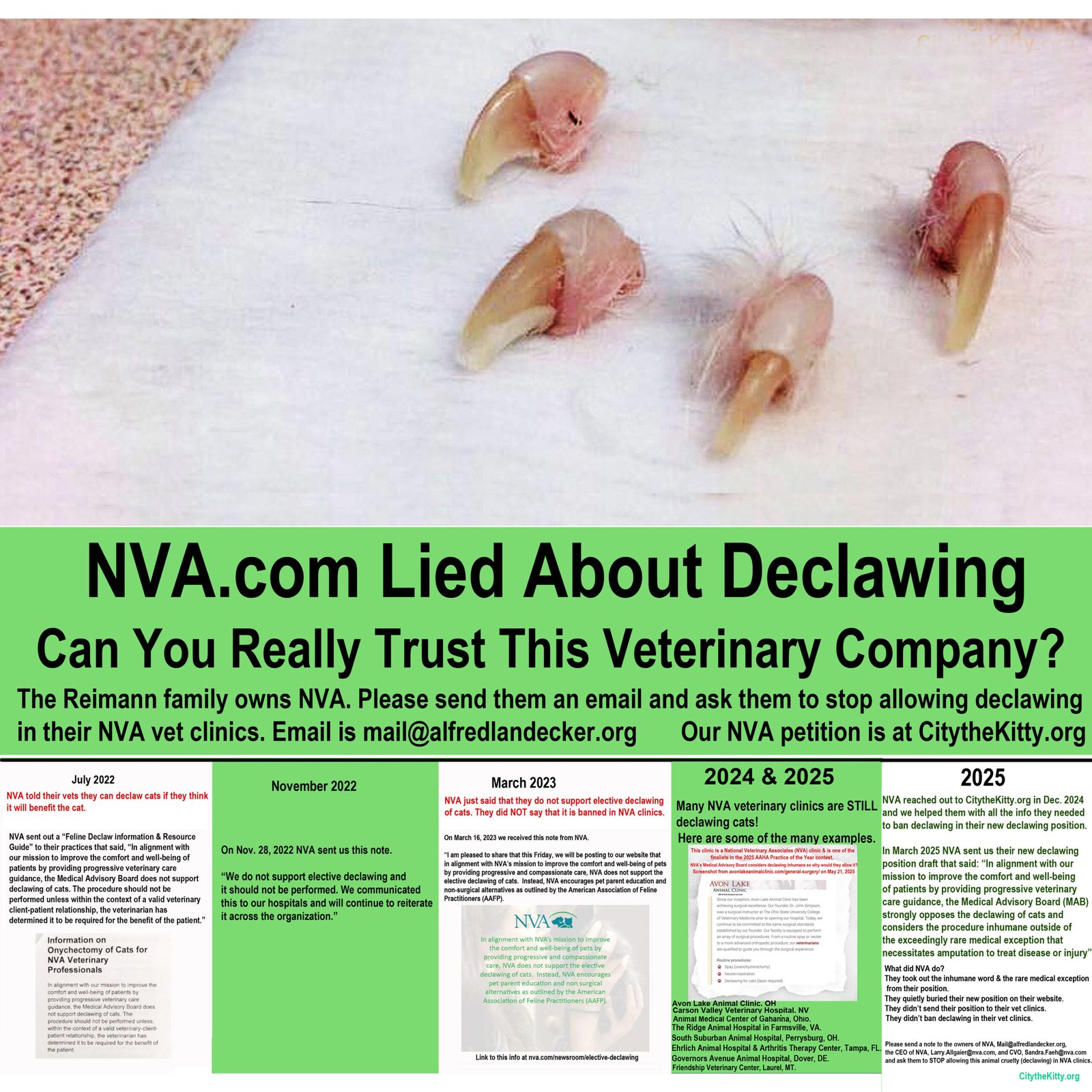
On November 28, 2022 NVA sent this email to City the Kitty nonprofit, “We are proud to share NVA has adopted a stance very similar to the German law you originally cited when you reached out to NVA earlier this year. We do not support elective declawing and it should not be performed. We communicated this to our hospitals and will continue to reiterate it across the organization.” (NVA did not send that to their hospitals or tell them that declawing should not be performed and many of them continue to declaw cats.)
NVA veterinary leaders, including Sandra Faeh, wrote in their 2025 declawing policy draft that their company sent to City the Kitty nonprofit on March 17, 2025, said this, “In alignment with our mission to improve the comfort and well-being of patients by providing progressive veterinary care guidance, the Medical Advisory Board (MAB) strongly opposes the declawing of cats and considers the procedure inhumane outside of the exceedingly rare medical exception that necessitates amputation to treat disease or injury.”
These NVA leaders decided to take out the sentence where they declared declawing inhumane and posted this watered down position in June 2025 on their website, “In alignment with our mission to improve the comfort and well-being of patients by providing progressive veterinary care guidance, NVA strongly opposes the declawing of cats and does not support the practice of elective declawing across our network of veterinary hospitals. Instead, we encourage pet parent education and non-surgical alternatives.”
DECLAWING IS STILL ALLOWED AND IS BEING PERFORMED ROUTINELY IN MANY NVA.COM VET CLINICS.
Here’s the full shocking story. https://citythekitty.org/a-legacy-of-cruelty-reimann-familys-veterinary-company-nva-allows-declawing-despite-calling-it-inhumane/
—————————————————————————-
AVMA Delegates and Declawing.
Dr Bridgette Heilsberg. AVMA Alternate Delegate for Texas.
Crown 3 Equine Veterinary Services
Dr Heilsberg is the AVMA delegate who is quoted in this AVMA story and says that the word “may” is a more defensible term when it comes to the negative issues caused by declawing.
Our researchers looked into how her clinic addresses declawing and found that Dr Heilsberg doesn’t declaw cats but her staff recommend a declawing clinic that is owned by an 18 year AVMA member vet that declaws cats very often, will do 4 paw declaws at different times, declaws older cats, and says it’s ok for a cat.
The employee said Dr Heilsberg’s clinic is a mobile only clinic and can perform a neuter at your house with a sterile mat on the floor but the employee said the declaw is the removal of the digit on their fingers, it’s considered an amputation and that’s better done in a hospital setting since there’s a little bit more risk for infection and is a more invasive procedure.
Researcher asked if it’s bad for a cat. The employee said, “No, it’s not necessarily bad, it’s just the way the procedure is, they remove the bone so it needs to be done in a sterile setting.”
Researcher asked if there are clinics that declaws cats in the area.
The employee said to try All About Pets in Whitesville or Dr Shelton in Collinsville for a declaw.
Researcher asked again if a declaw is ok for a cat and the employee said, “Yea, absolutely” as long as it’s an indoor cat, as long as you are familiar with the procedure and they will have to wear “foot wraps” for awhile, each doctor is a little bit different on how they do them and to make sure you go over bandage procedures and what’s required.
They repeated a declaw is ok for the cats as long “as it’s an inside cat with no risk of going outside” since outside cats need their claws to defend themselves, but if it’s an indoor cat the employee said, “Sure, there are plenty of places that do it. “
Asked again if the cat is going to be ok long term with no problems and they said, “I think it depends on the procedure” and it’s best to talk to the surgeon who is going to do it.
They said that they see mostly equine patients and are mobile only.
Shelton Veterinary Hospital, Collinsville, TX
Dr Bob Shelton, AVMA member for 18 years.
The employee said that Dr Shelton uses a scalpel for their declaws and he will not do an all four feet declaw in one surgery. He will only do 2 feet at a time. They said that the neuter and front feet which is “normally the feet we start with” it’s $400.
They said that you can come back in about a month and get the “2nd round” (the back feet declawed) and it would be $50. They said that they don’t do a lot of “double declaws.” They have to wait for the front to heal before you can do the back.
Researcher asked if the cats are ok long term and the employee said, “With any declaw it is very invasive, so yes they do ok” and said if they do it with a laser, scalpel, or guillotine clippers, any of those ways can end up in behavioral issues. The employee then said, “Healing wise they do fine.”
Researcher asked if they have those behavioral issues often and the employee said, “It’s sporadic and there’s not really any way to say they will have them or not.” They said there are cats who don’t want to use the litter box after a declaw.
They went on to say, “We don’t have too many issues with them but there are the few every now and then that already have behavioral issues that it kind of just makes it worse.”
Researcher asked if a declaw should be ok for a cat and the employee said, “Yes as long as he’s not having behavioral issues, it should be fine.”
They also said that it’s a possibility that the cat could end up with behavioral issues after a declaw.
Researcher asked if Dr Shelton does declaws often and the employee said, “Yes, we do them very often.”
Researcher asked if those cats have been ok and the employee said, “Yes, they have been.”
They said the only ones they see major issues with are the ones that already needed something like Prozac and the owner decided to declaw them first to help with an issue with the cat “mauling” them and then they become angrier kitties. They said they don’t see those too too often. The employee said if that happens then they just give the cat Prozac.
They said as long as the cat has the rabies vaccine within the year you can just make the surgery appointment and drop the cat off and pick them up the next day. They said they offer blood work but that can be done the same day.
They said they give a pain injection and give you liquid or tablet pain meds for 3-4 days and they use glue on the amputation sites.
They said the cats heal up in 10-14 days for the skin to fully be healed and typically they don’t need pain meds for all the days.
Researcher asked if they have an age limit. The employee said not typically and said they haven’t had any older cats come in and the oldest they have seen them get a declaw was 5-6 years old.
Not once did they mention the humane options.
All About Pets in Whitesville, TX.
They said they don’t declaw cats. Researcher asked why they don’t declaw cats. They said their doctors choose to not declaw and you are taking their first knuckle and it’s very, very painful, if you declaw they have to be indoor for the rest of their lives and it’s bad for them long term. They said they used to do them but don’t do them anymore.
——————————————————————————————————————————————————-
Dr Lindy Lee O’Neal. Arkansas AVMA Delegate
Animal Medical Center. Arkansas. Two locations, Pinnacle Hills and Midtown.
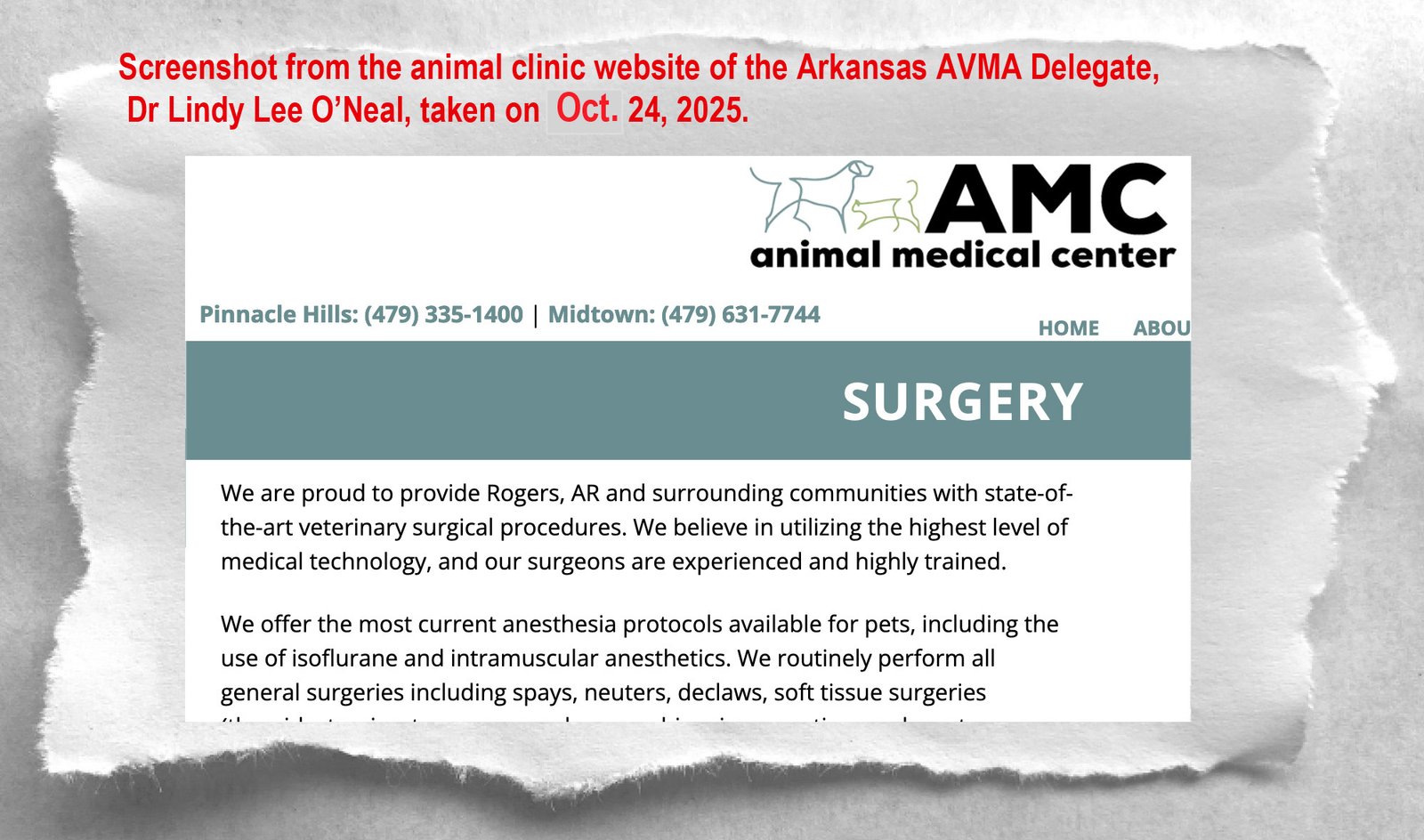 Link to their “We routinely perform all general surgeries including spays, neuters, declaws,…” page. https://www.amcrogers.com/services/surgery/
Link to their “We routinely perform all general surgeries including spays, neuters, declaws,…” page. https://www.amcrogers.com/services/surgery/
Pinnacle Hills location.
The employee said you have to come in for an exam first to talk about the declaw and after the exam they can set up an appointment for it. They said they only have one vet, Dr Dickey who does their declaws. They said they do not perform them very often and said, “most people don’t do them anymore.”
Researcher asked if the cats are ok after the declaw and they said that’s a question for the doctor.
Midtown location.
The employee said you need a consultation first to talk about the “pros and cons of declaw.”
The employee said, “We do them on a case by case basis, we don’t prefer to do them, if that makes any sense.” They said any of their vets can do the declaws.
———————————————————————————————-
Dr Jessica Lauren Stroupe. AVMA Delegate for Missouri
Howard County Veterinary Services P.C., Fayette, MO
Declaw discharge instructions link.
Researcher called this clinic and asked for the cost of a neuter/declaw for a 5 month old cat and Dr Stroupe was the person who answered the phone.
Researcher asked if they have a vet who is a surgeon that does their declaws and Dr Stroupe said, “We’re licensed veterinarians that perform the declaws, there’s two of us that do them routinely.”
She said they like to make sure clients are educated about it because there are a lot of studies out that show there can be chronic pain. She said in general when you do them when they are young at 5 months old they recover and do pretty well but always try to educate their clients on using scratch posts and different materials before resorting to a declaw.
She said she has done “a lot of declaws”, uses a scalpel for them, and has been practicing for 13 years. Researcher asked if those cats are ok long term, and she said, “Yea, most of them do fine. “ She said, “We’ve had a few deal with pain a little longer but all of them go on to recover pretty well” but sometimes they have to send them with more anti-inflamatories and have had a few where their incision got pushed back from scratching so she had to repeat the surgery but said there’s always complications anytime you do a procedure but most of them recover well.
She said they always explain it to people because if you look at your fingers you have three joints, and said it’s the equivalent of removing the last joint on the finger on a cat. She said it can be pretty painful so they send them home with a lot of pain medications.
She said there are studies that show that 40% of cats will have some degree of chronic pain from a declaw and said they always try to explain it to people and said “we still perform the procedure if needed” but try to get people to try the scratch posts first and other methods.
She sends 6 days worth of pain meds home and a topical opioid that helps with the pain.
The declaw and a neuter/declaw/pain meds is $284.97
———————————————————————————————–
Dr Stephen J. Dullard. Illinois AVMA Delegate.
Ancare Veterinary Hospital , Two locations in Illinois.
Ancare Veterinary Hospital lists the “Pros and Cons of declawing” on their website and they say, “Visit our office to get the latest in top-quality veterinary care …” on their website.
La Salle location.
The employee said that on their estimates they have a lower end which is everything that’s required and higher end, and using a laser is in the higher end. They said it is cheaper doing a declaw with the neuter and not separate.
A neuter declaw is $900-$1000.
Researcher asked what vet does their declaws and the employee said all their doctors can do the declaws.
Researcher asked if the cats are ok afterwards from the laser declaws and the employee said yes, “They all heal up fine afterwards” all their doctors are certified across the board on everything and they all have done neuters/declaws.
Researcher asked if they do the declaws regularly and the employee said, “Yep, we do them pretty regularly, just the fronts” and said they don’t declaw all four paws.
Mendota location.
Researcher asked for the cost of a neuter/declaw. They said that the technicians give the estimates.
Researcher asked who is their declawing vet and the employee asked, “Are we doing front or all four?” They said that their declawing vets are Dr Dullard and Dr Elizabeth (member of the AVMA for 9 years) and the employee double checked if they also do 4 paw declaws and said they only do front declaws.
Researcher asked if they do declaws regularly and the employee said, “Yes, we do” and said they have had many declawed cats as clients.
They said they have done plenty of declaws and they have never had any issues there.
—————————————————————————————————————————————————–
Altoona Veterinary Hospital. Altoona, Iowa.
Dr Bill Jones. AVMA Delegate for Iowa.
They said that they don’t declaw cats. Researcher asked why they don’t declaw cats and the employee said declawing is being phased out in the veterinary world. They said it’s not medically necessary and a lot of clinics won’t do them. Researcher asked if declawing is bad for a cat and they said it can be, it’s like taking off the tip of your finger and can sometimes lead to pain and is not healthy for a cat.
They offered a recommendation of a clinic in Des Moines that still performs declaws, Fleur Pet Hospital.
Fleur Pet Hospital. Des Moines, Iowa.
Link to Fleur Pet Hospital’s declawing page.
Researcher asked for the cost of a neuter/declaw at Fleur Pet Hospital and the employee asked, “Are you just wanting the front two declawed or also wanting all four?”
A neuter/2 paw declaw is $1055.95 and a neuter/4 paw declaw is $1120.95.
They said their declawing vet is their owner, Dr Lisa Williams, member of the AVMA for 35 years. The employee said she uses a scalpel and needles and she takes particular care that everything is removed successfully and closed up and healed.
Researcher asked if she does declaws regularly and the employee said yes, she does them “every now and then here.” Researcher asked if the cats are ok after the declaws and they said they haven’t had any complications with their neuters/declaws. The cats stay 1-2 days, depending how they heal up.
The employee did not mention any of the humane alternatives.
—————————————————————————————————————————-
Dr Chuck Barry. Alternate Delegate for Missouri.
Lifetime Animal Clinic. Warrensburg, MO
The employee said Dr Chuck Barry and Dr Sharon Keairnes, also an AVMA member vet, perform their declaws.
They said that a neuter/2 paw (front or rear) declaw is $300 and a neuter/4 paw declaw is around $400.
Researcher asked if the cats are ok after a declaw they said yes.
Researcher asked if they do declaws regularly and the employee said they do them every few months or so.
The employee said that they use a laser for the declaw and it’s not as invasive and it helps to not bleed as much.
Researcher asked if their cats are ok long term and the employee said, “Oh yes, absolutely. We wouldn’t continue if they were not.”
They said, “All of our kitty cats do pretty well.”
——————————————————————————————
Dr Travis McDermott. Alternate Delegate for Nevada.
Durango Animal hospital. Las Vegas, NV. (Nevada story and 2014 fb post.)
Researcher asked for the cost of a neuter/declaw and they said that a neuter is around $190 and a declaw for the front feet is around $175.
Researcher asked who is their declawing vet and the employee checked and said, “I spoke with Dr Martinez and she is comfortable doing the declaw.”
Researcher asked if the cats are ok after a declaw they said yes and if they have any problems and the employee said they are typically in some pain and need to recover for a few weeks and said, “they recover fine.”
Here’s some info from our 2021 story about the anti-declawing bill in Nevada.
Screenshot of a facebook comment from a cat owner who had her cat declawed at Durango AH.
Durango Animal Hospital “liked” her comment.
2021. Employee said that all their doctors perform declaws regularly. A declaw is from $300-$400. They said they only do the front or the back and won’t do an all four paw declaw.
——————————————————————————————————————————-
Dr Steven A Stelma. AVMA Delegate for North Carolina.
Animal Care Center, New Bern, NC.
The employee said that a declaw is around $400 and they only do the front two paws. The require an exam first. Researcher asked who their declawing vet is and the employee said that they have two that are willing to do a declaw, Dr Stelma and Dr. Anthony Weshefsky, who is a 36 year AVMA member.
Researcher asked if the cats are ok after the declaw and the employee said, “there is some debate about that.” They said a lot of doctors don’t like to perform declaw surgeries because it cuts off “part of the limb.”
They said if the issue is scratching furniture, there are other things they would suggest first, like scratching posts, nail caps, but said the doctor would do the declaw but they have to consult with the client first.
They said that Dr Selma “keeps his kids” for about one night and Dr Weshfesky “keeps his kids” for two nights to keep an eye on them.
Researcher asked if they do declaws often and said they said declaws are not as common as it used to be but they are very good surgeons and they still get done every so often.
——————————————————————————————————–
Dr Mike Jones. AVMA Delegate for Oklahoma.
Woodland West Animal Hospital. Tulsa, OK.
AAHA Accredited Animal Hospital.
The employee said a neuter is $155 and the employee stated, “A declaw, the front paws only, is going to be $577.50.” They said that Dr Jones is their only vet who performs declaws and he uses a laser.
Researcher asked if the laser better for the declaw and the vet tech answered the question and said it helps with healing and everything. They said that Dr Jones is “is really good with declaws.”
Researcher asked if the cats are ok long term after a declaw and the vet tech said there’s always a chance for issues developing like arthritis and tenderness in their paws. They said if it’s not necessary they try not to do them but if it is necessary they will do them.
Researcher asked if Dr Jones does declaws regularly and they said, “He does them quite often.”
Researcher asked again if those cats are ok and the employee said, “For now yea. As they get older they are more prone to arthritis” and said a declaw is “taking the last little chunk of the finger off” and it’s not just taking off the nail.
—————————————————————————————————————-
Dr Tiffany Healey. AVMA Delegate Wyoming.
Cottonwood Animal Hospital. Cheyenne, WY
They said that they only perform declaws if they are medically necessary for the cat and that a declaw is very painful. Researcher asked if a declaw is bad for a cat and the employee said, “Oh yes, it’s very painful for the kitties to have their claws removed.”
Researcher asked if it causes problems for the cat the employee said no and said that years ago they had their indoor cats declawed so they didn’t tear up the furniture or drapes and there were no problems. But they said veterinarians in America are not doing it as a routine procedure anymore because there has to be a medical reason for the declaw.
Gilbert Veterinary Hospital. Gilbert, AZ
Dr Melinda Patterson. AVMA Delegate for Arizona.
They do not declaw cats. Researcher asked why don’t they declaw and the employee would not say and said to go find a clinic that does.
————————————————————————————————————————————————–
Small survey of AVMA member veterinarians who declaw cats.
Dr Jan Pol. 54 Year AVMA Member Veterinarian.
Pol Veterinary Services. Weidman, MI
His vet clinic, Pol Veterinary Services in Weidman, MI
Sept. 2025. According to staff at his vet clinic, they still declaw cats and said Dr Pol still declaws cats but you have to be a current client and they are not taking new clients.
Here’s our story about Dr Pol and declawing.
Dr Wayne Anderson. Arizona AVMA member veterinarian.
Our story shows you how common declawing is in Lovet Pet Healthcare clinics , previously AzPetVet Clinics, owned by Dr Wayne Anderson.
Here are some of the lies and misinformation that Dr Wayne Andersaon said in his testimony, “We also, on occasion do a declaw procedure. Maybe one or two a doctor might do in a years time.” “Most cats do not let their nails be trimmed.” “Those little caps are silly. Those don’t work.” “It’s a very successful surgery, on occasion.” “We don’t do them that often, it’s very rare.”
Dr Joanne Carlson. 33 year member AVMA veterinarian.
Loving Care Animal Hospital. Palatine, IL
Here’s our 2023 story, “Lying To Legislators and the public: Illinois State Veterinary Medical Assoc. and Their President Dr Joanne Carlson Have To Lie About Declawing Because the Truth About It Is Just So Brutal and Awful.” that documents all of Dr Carlson’s and the ILVMA’s lies about declawing.
She was quoted in a story in the Courier Journal and The Telegraph as saying these comments at the state veterinarians council.
“To be clear, Illinois veterinarians perform feline onychectomies infrequently and any suggestions that this is a common practice are untrue,” Carlson said. “When it is done, as a last resort, it is to protect the health and well-being of the cat.”
There is no evidence that cats who have this procedure experience any long-term difficulties, Carlson said.
“Modern declawing is no more painful or complicated than one might expect from a spay or neuter procedure,” she said.”
Dr Erin Giebel. 22 year AVMA member
Savannah Animal Hospital. Lewes, DE
This is an AAHA.org and NVA.com Animal Hospital.
These are some of the things the President of the Board of Veterinary Medicine for Professional Regulation, Dr Erin Giebel, said to the Senators in her testimony in 2022 against the DE anti-declawing bill. (Here’s our 2022 story about how Dr Whaley and 4 other veterinarians stopped the anti-declawing bill in Delaware.)
She feels this procedure should still be allowed to be performed with a discussion with their veterinarian on different options and the “side effects” and “long term things.”
She said, “For some pet owners we know that this this is the option that is best for their individual situation.”
She said the declawing procedure has been improved over the years and they use a lot more both pre-op and post op pain management.
She said, “These animals come out usually feeling fairly good after the procedure and the days following.”
She said, “Definitely it is down in how frequently we’re doing it. I think in our practice we did one all month. So not very frequent as far as that goes.”
Dr Geibel said she wanted to reiterate this, “Everybody is saying trim the cat’s nails or apply the Soft Paws. That’s not always the easiest thing for all these cats. Not all cats allow an owner to do it. So it’s catching a cat, taking it to the hospital, and having to have two or three technicians to hold it to do a nail trim. And applying the Soft Paws does take some flexibility to apply that as well.”
Many things in veterinary medicine and in handling animals are not easy but that doesn’t mean any type of animal cruelty should be condoned.
She said, “As far as this being a cruelty thing and our investigators having to go investigate and the board hear all the claims, there are more important things, I think that our board needs to be focusing on for our patients and the Delaware community.”
She said, “So it is our hope that you will not vote in favor of this bill and allow us to continue to allow the veterinarians and their clients to make their decisions for their individual pets.”
September 2025
Researcher asked for the cost of a neuter/declaw and the employee said you need an exam first to talk to the veterinarian about the timing of it and to see if it’s necessary. Researcher asked what they meant about “necessary.” They said the circumstances around it, like if you are on any medications, blood thinners, if they are tearing up the house, or attacking you. The employee said they have 4 doctors who do their surgeries and weren’t sure which ones perform the declaw.
June 2022
The employee said a neuter is from around $500-$600 and a declaw is an additional $200-$300. They use a laser and they say that it is better because it cauterizes, minimizes blood loss and swelling.
The employee said that Dr Clifford Howard, Dr Christine Clark, and Dr Melissa Schwarmann perform their declaws.
The researcher asked if the cats are ok after a declaw. The employee said, “Yes, it’s going to take some recovery and it’s definitely a recovery process.” They said, “The cats usually do pretty well as long as you restrict their activity and give them time to rest their paws.”
The researcher asked if the cats are ok long term after a declaw. Employee said yes.
The researcher asked if they do declaws regularly. Employee said yes.
—————————————————————————————————————————————————-
Link to Capital City spay and neuter clinic’s website. Capital City Spay & Neuter website
2022. We looked into how this clinic addresses declawing and for the cost of a declaw.
The employee said that a 4 paw declaw is $260.
They said that Dr Christinna Murphy does their declaws, she uses a scalpel, and she’s been a vet for 20 years.
Researcher asked if Dr Murphy does declaws regularly and the employee said, “She’s been practicing for 20 years, yes.”
Researcher asked if declawing is ok for a cat long term. The employee said that it is as long as you follow post op instructions.
The employee was asked about the information on the internet that says declawing is bad for a cat and they said, “Well the internet has a lot of misinformation, so as long as you follow post op instructions that we recommend, the cat does great after the procedure.”
The employee said you can just drop off the cat for the exam/declaw.
Here’s this AVMA veterinarian’s price list.
Declaw aftercare instructions link.
Here are some declawing reviews on YELP about declawing and this AVMA veterinarian’s clinic.
——————————————————————————————————————————————–
Dr Nolan Keith Beech. AVMA member.
Washington County Veterinary Clinic, Chatom, AL
Dr Beech sent this Letter to the Editor to the AVMA’s Journal in 2020 and said he has declawed his own cats and will declaw the next one. He said those cats walk, eat, drink, and act normally the day after surgery and often spend considerable time removing the bandages from their feet, which I would not expect them to do if they were in extreme pain.
The AVMA’s Chair, AVMA Animal Welfare Committee, Jyothi V. Robertson, dvm, responded and said, “The AVMA agrees with Dr. Beech that veterinarians need to be able to exercise their professional judgment when deciding how to best protect their individual patients’ health and welfare.”
Our researchers looked into how much a neuter/declaw costs at Dr Nolan Keith Beech’s vet clinic, Washington County Veterinary Clinic, in Chatom, AL.
The employee who has worked there for 20 years said that a neuter/2 paw declaw is $220. They said that they don’t like to do the 4 paw declaws in case the cat gets out and needs to climb a tree and it’s for their benefit, but Dr Beech will do them. They said it would be another $100 for the back.
Researcher asked how he performs their declaws and the employee said, “We remove the claws with scissors.” Researcher asked again to confirm how he performs the declaws and they said he uses a scissor and scalpel.
Researcher asked if the cats are ok long term and the employee said yes and said that their veterinary cat is declawed this way. They said that they have never had any issues with their declawed cats.
Researcher asked if Dr Beech does declaws regularly and the staff said, “We just had two leave that we did yesterday.”
They said the cat goes home with the bandages on if they still have them on their feet and said since cats don’t like “stuff” on their feet and sometimes they have already gotten them off. They send you home with 3 days of pain meds.
Researcher asked if he takes off the bone or just the claws. The staff said, “Just the claws.”
Researcher wanted to confirm and asked if they take off bone and the employee said no.
——————————————————————————————————————————————————————————————–
Dr Donald St Ledger, a 47 yr American Veterinary Medical Association (AVMA) member veterinarian.
Albion Veterinary clinic. St Albion, IL
Here’s our 2023 story that shows you how some AVMA declawing vets do not give their declawed cats any pain meds.
Irma the cat is one of the many innocent cats that Dr St Ledger has declawed. He does not give take home pain meds for their declawed cats.
Here’s a post from a cat owner who had their cat declawed by this Illinois vet, Dr Donald St Ledger. 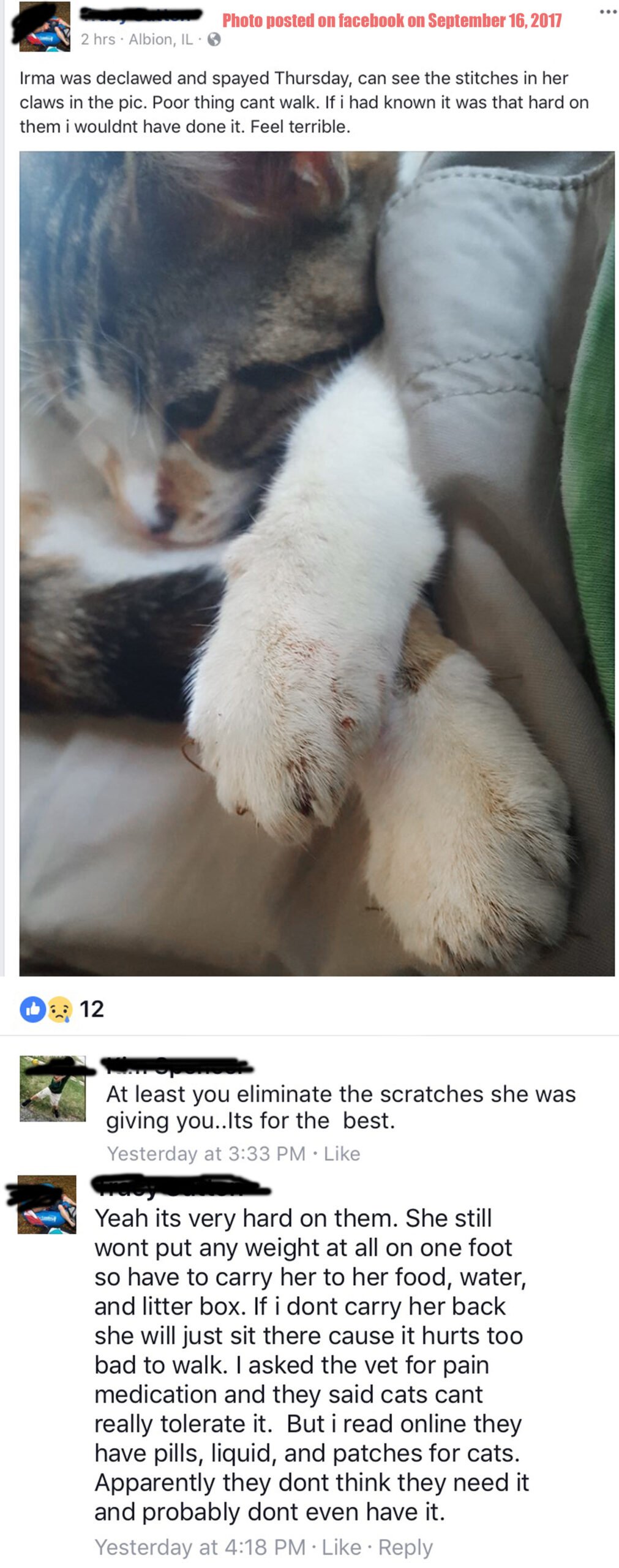
——————————————————————————————————————————————————————
Here’s a 31 year AVMA member vet, Dr Rita Mazzuchi, who declaws cats and says on her website that her laser declaws are “virtually bloodless and painless.”
Ross Hospital for Animals. Bloomfield Hills, MI.
AAHA Accredited Animal Hospital
This is the info that this AAHA Accredited Animal Hospital has on their website on May 27, 2025.
“At Ross Hospital for Animals, we use a surgical laser to perform the onychectomy (declaw) surgery. We recommend declawing after all other attempts to train your cat have failed. Surgical laser offers the safest, least painful method of declawing available today. Laser surgery eliminates any painful regrowth of nail tissue because the entire claw and attached, non-weight-bearing bones are surgically removed. Your cat can quickly return to normal activity, usually within one to three weeks following surgery. The laser makes this surgery virtually bloodless and painless.”
1) No animal hospital should EVER recommend declawing
2) They say, “Surgical laser offers the safest, least painful method of declawing..” This is a blatant lie. You can read the studies in our FACTS VS MYTHS #8 Section that show that laser declawing is not less painful and actually has more complications than scalpel declaw.
3) They say, “Your cat can quickly return to normal activity,…” This is a lie. Cats need their toe bones and claws for so many aspects of their health and well being! Removal of a cat’s toe bones and claws means the removal of a cat’s ability to stretch its its back muscles and it changes the way in which their feet hit the ground. This can lead to back problems, including pain and muscle atrophy.
Their website says that their laser declaw is virtually bloodless and painless.
An employee at this AAHA hospital in 2024 said they only take the nail off rather than going down to the knuckle. Link to their bloodless and painless laser declaw info. https://www.rosshospital.com/feline-declaw-laser-surgery/
(Declawing always involves taking off the last bone in a cat’s paw otherwise the nail will grow back.)
2025. Researcher asked for the cost of a neuter/declaw and the employee asked, “Were you looking for all four paws declaw or just the front?” Their rough cost for a 2 paw declaw/neuter is $1100 and a 4 paw declaw/neuter is $1255.
The researcher asked what vet does their declaws and the employee said Dr Mazzuchi does all their surgeries and she uses the laser for their declaws. The researcher asked if the laser is better for a declaw and the employee said yes, because it allows the healing process to go a little bit easier. Researcher asked if the cats are ok long term after a declaw and the employee said, “Yea, yea, usually there aren’t any further problems with that.” Researcher asked if Dr Mazzuchi does declaws regularly and the employee said yes.
2024. Researcher asked for the cost of a declaw and the employee asked, “Would you be doing the front declaw or all four?”
A four paw declaw is $1300 and 2 paw is $1200 plus the cost of meds to go home.
The employee said that Dr Mazzuchi does their declaws with a laser.
Researcher asked if she does declaws regularly and the employee said, “Yep, she’s been here for almost 30 years.” The employee said that Dr Mazzuchi just had a declaw the other day and said, “she does them quite often.”
Researcher asked if the cats are ok after a declaw and they employee said, “Umm, yea” and laughed. They said you can do a little bit more research on declawing and that would be able to tell you more.
Researcher asked how the laser is better for a declaw and the employee said that it’s quicker healing and said, “We only take the nail off rather than going down to the knuckle.”
Researcher asked, “Dr Mazzuchi only takes the nail off and not the knuckle?” and the employee said, “correct.”
Researcher asked the employee how they know that Dr Mazzuchi only takes off the nail and they said that the tech is back there with her is there when she does the surgery.
Dr Jim Clark. 40 year member of the AVMA.
Jefferson County Animal Hospital, Waurika, OK
Here’s a disturbing video of a couple cats that he declawed.
Dr Jim Clark does not give any pain meds for the cats after a declaw according to an employee who works there.
September 2025
The researcher asked for the cost of a declaw and the employee asked, “Do you want just two feet done or all four?”
They said a two feet declaw is $144 and all four feet is $160 and Dr Clark does the declaws. The employee said that they use a laser for the pain and not to cut. The employee said he does NOT give medication to the cats for the pain and just uses a laser for the cat’s pain.
They said that it’s your choice to do a neuter/declaw on separate days or at the same day.
March 2021.
They say a declaw is $95 and you have to wait until the front paws are healed to get the back done which would be another $95. They said it’s best to wait about 2 months.
They said that Dr Clark cuts the nails out and the cat is usually sent home the same day. If the laser therapy is used they don’t send the cats home with any pain meds.
2016
They do NOT counsel you about the humane alternatives or educate you about what declawing entails when you ask to get your cat declawed at this animal hospital. (One employee said that sometimes when they declaw the cats they get mean and bite.)
They will declaw your cat for $95. They say this vet uses, “special nail clippers/trimmer to pull the nails out while your cats are sedated.” (At least 30% of vets still use the guillotine clippers to declaw cats)
They say that for $15 more you can get their Cutting Edge MLS laser therapy treatment which cuts the healing and pain in half and will last 5 days.
When you ask them if you can get pain meds for your cats, they say that they don’t provide them.
————————————————————————————————————
Dr Jan Sosnowski, past AVMA Delegate/46 year AVMA member vet.
Governor’s Avenue Animal Hospital, Dover, DE.
This is an NVA practice. NVA veterinary leaders consider declawing “inhumane” but still allow it in their clinics and lied to City the Kitty nonprofit after they helped NVA draft a new declawing position statement.
Governor’s Ave. Animal Hospital’s Facebook page
Dr Sosnowski is also a Past President of the DVMA.
Here’s Dr Jan Sosnowski’s July 2022 written letter of opposition to the 2022 Delaware anti-declawing bill.
(If the bill would have passed, it would have been easy to decide if a declaw was “medically necessary” for the cat since it would be in cases where a cat had a tumor on its paw or an injury to its toes.
Here’s what we found about Dr Jan Sosnowski’s practice in regards to declawing.
October 2025. According to an employee, Dr Jan is still performing declaws. Researcher asked for the cost of a neuter/declaw and they said you need a $400 pre-op exam first to get tests done and to “discuss the pros and cons” of declawing. Researcher asked if they would do the neuter/declaw after the exam and the employee said, they have to make sure the blood work is ok first and then they could proceed with the procedures. They said it’s around $600 for a neuter/declaw.
June 2022.
Researcher asked for the cost of a neuter/declaw. Employee said a neuter/declaw is $600-$900 depending on the cat’s weight.
Researcher asked what surgeon they recommend for declaws. Employee said, “We would definitely get you scheduled for that, Dr Jan (Sosnowski) is normally the one that does them the most.”
Researcher asked if she does declaws regularly and the employee said, “Yes, she just did one today.”
Asked if the cats are ok long term. Employee said yes and said, “We don’t have any complications or any that come back.”
Employee said that you need to make an appointment and discuss any concerns and if the cat is healthy enough then the procedures will be scheduled.
Another employee was asked for the cost of a spay/declaw and about a veterinarian for the declaw. They said all 5 of their doctors do declaws.
In 2022 Dr Jan Sosnowski was a Fear Free Certified veterinarian according to FearFreePets website, so if this employee is correct, then these two vets, Dr Jessica Street and Dr Erika Gennusa, are also breaking Fear Free’s no-declaw rule.
—————————————————————————————————————————
Dr Anne Kulp, long time AVMA member veterinarian.
Pet Day Surgery, Lebanon, PA.
They advertise their declaw procedure on the sign out in front of the practice.
They have a photo on their facebook page that says, “Near pain free cat declawing.”
Photo was taken by Google Maps in Sept. 2024
October 2025.
Employee said it’s $525 for a neuter/declaw and $375 for just the declaw and Dr Kulp performs their declaws.
Researcher asked if the cats are ok long term after a declaw and the employee said yes, “We have not had a problem” and laughed.
Researcher asked if she does declaws often and the employee said, “Oh yea.”
Here are some declaw reviews on Pet Day Surgery website. including one from cat owners in NY who drove to this clinic for a declaw because NY state banned declawing in 2019.
Here’s a facebook post in 2016 asking for a cheap place to get a declaw.
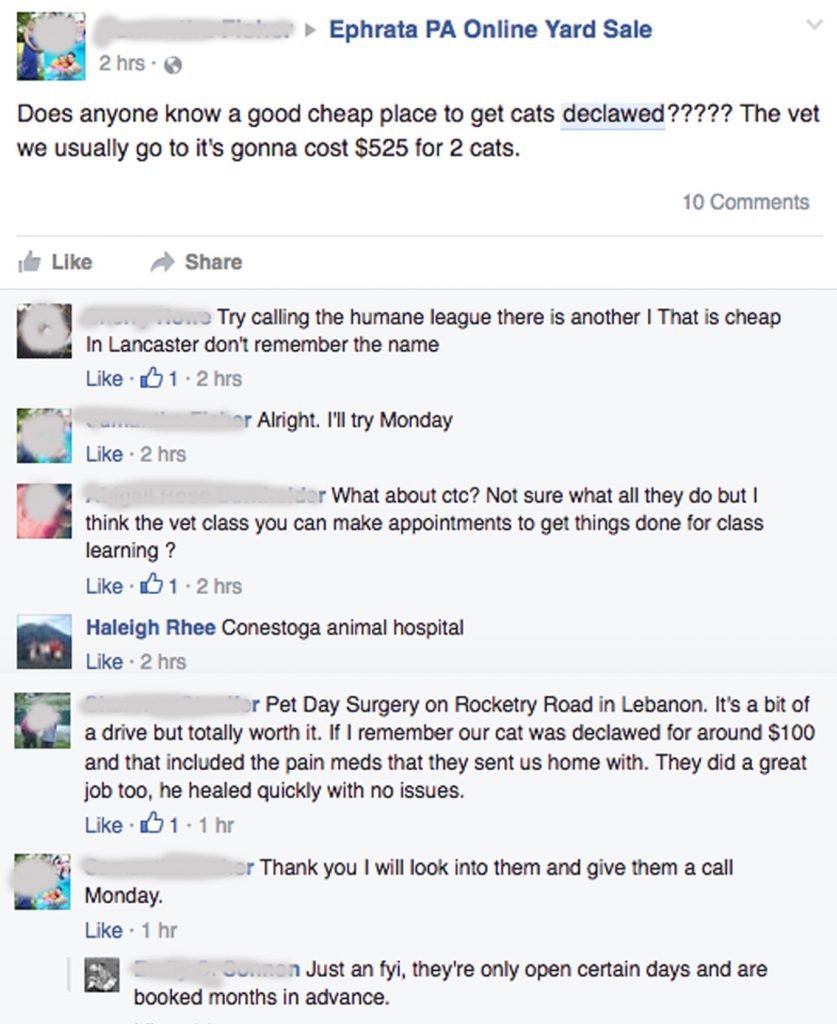
2016 story about the AVMA and declawing.

